Apollo 16: NASA's 5th crewed moon landing in pictures
Apollo 16 launched on April 16, 1972.
- Memento
- Apollo 16 crew patch
- Target acquired
- Geology trip
- Landing location
- Simulations
- Underwater training
- Water egress training
- Apollo 16 launch
- Mission Control
- The Blue Marble
- Earthrise
- Above the moon
- Craters craters everywhere
- Farside crater
- Roadtrip
- Apollo 16 Lunar Module shadow
- Plum Crater
- Sample gathering
- Stone Mountain
- Soil samples
- Sample collection Plum Crater
- "Moon"- buggy
- Final EVA
- Lunar boulder investigation
- Salute
- U.S. flag salute
- Lunar surface panorama
- Lunar surface experiments
- Scenic view
- Earth in enhanced color
- Hydrogen halo
- Lunar liftoff
- Service module inspection
- Breathtaking perspective
- Parachuting home
- Exiting the module
- Examining the goods
- Moon rock treasure
Memento
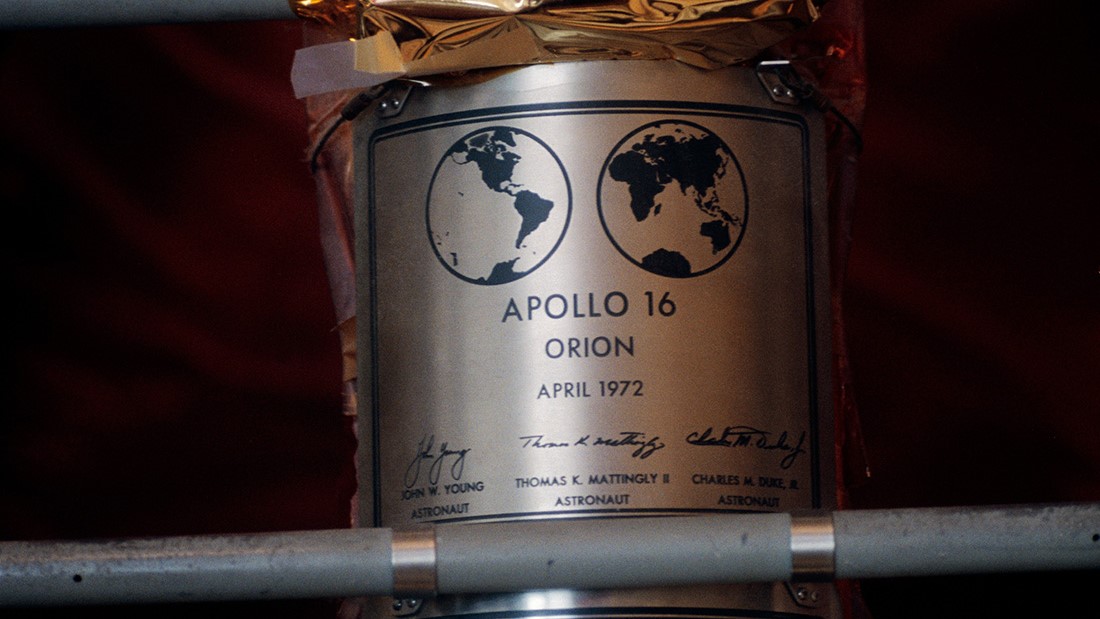
On April 16, 1972 NASA launched the Apollo 16 moon landing mission, which sent three astronauts to the moon's Descartes region. See photos from the historic flight in our gallery here.
First, a Memento: A plaque exactly like this was left on the moon by the Apollo 16 crewmen — astronauts John W. Young, commander; Thomas K. Mattingly II, command module pilot; and Charles M. Duke Jr., lunar module pilot.
Apollo 16 crew patch
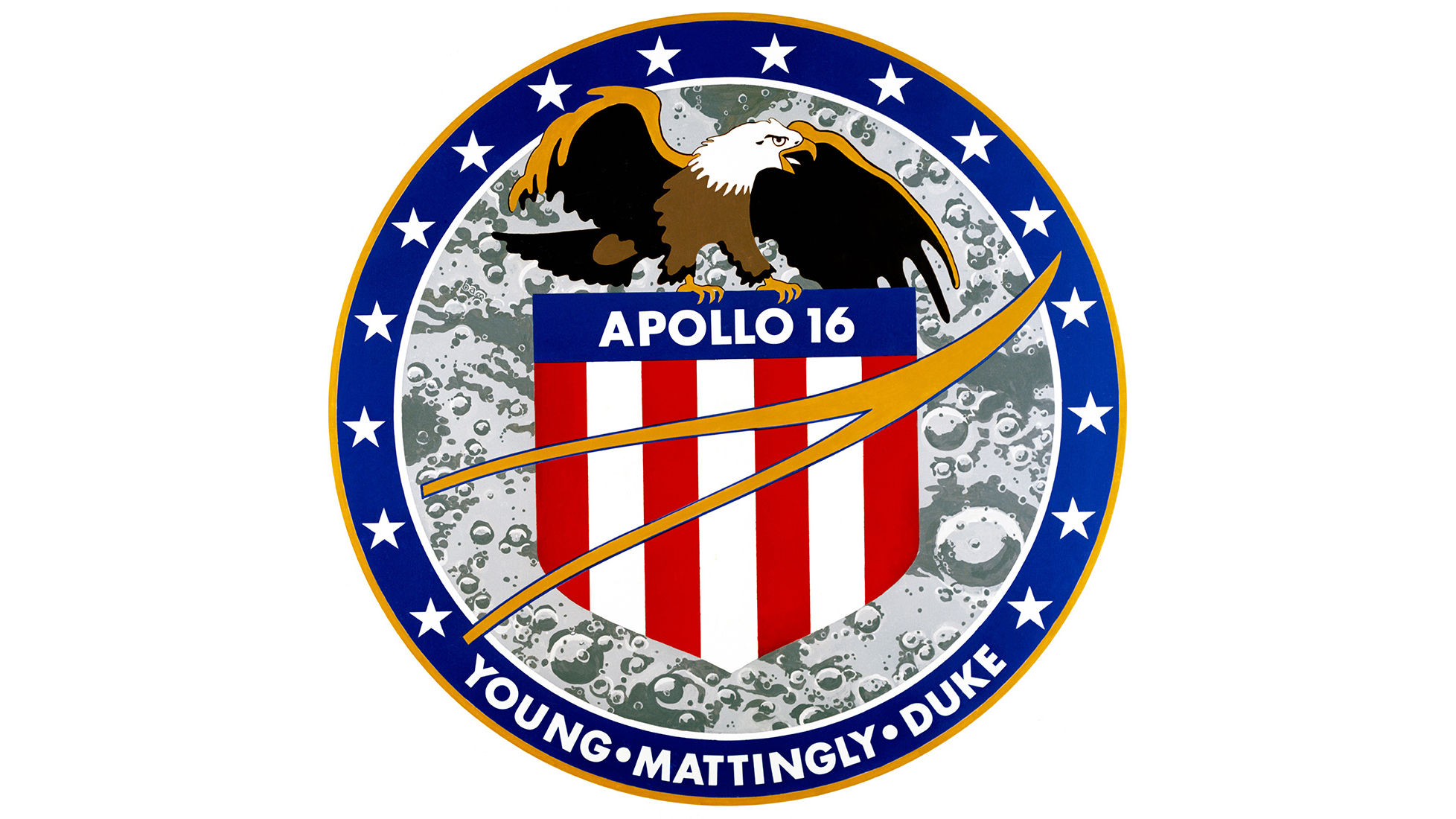
A NASA artist designed the official Apollo 16 crew patch from ideas the mission crewmembers — astronauts John W. Young, commander; Thomas K. Mattingly II, command module pilot; and Charles M. Duke Jr., lunar module pilot, submitted. The background consists of a lunar scene surrounded by a blue circle with 16 white stars and the crew's last names across the bottom. The dominant feature of the patch is an eagle perched on a red, white and blue shield. A symbol of flight in gold outlined with blue is emblazoned across the shield.
Target acquired
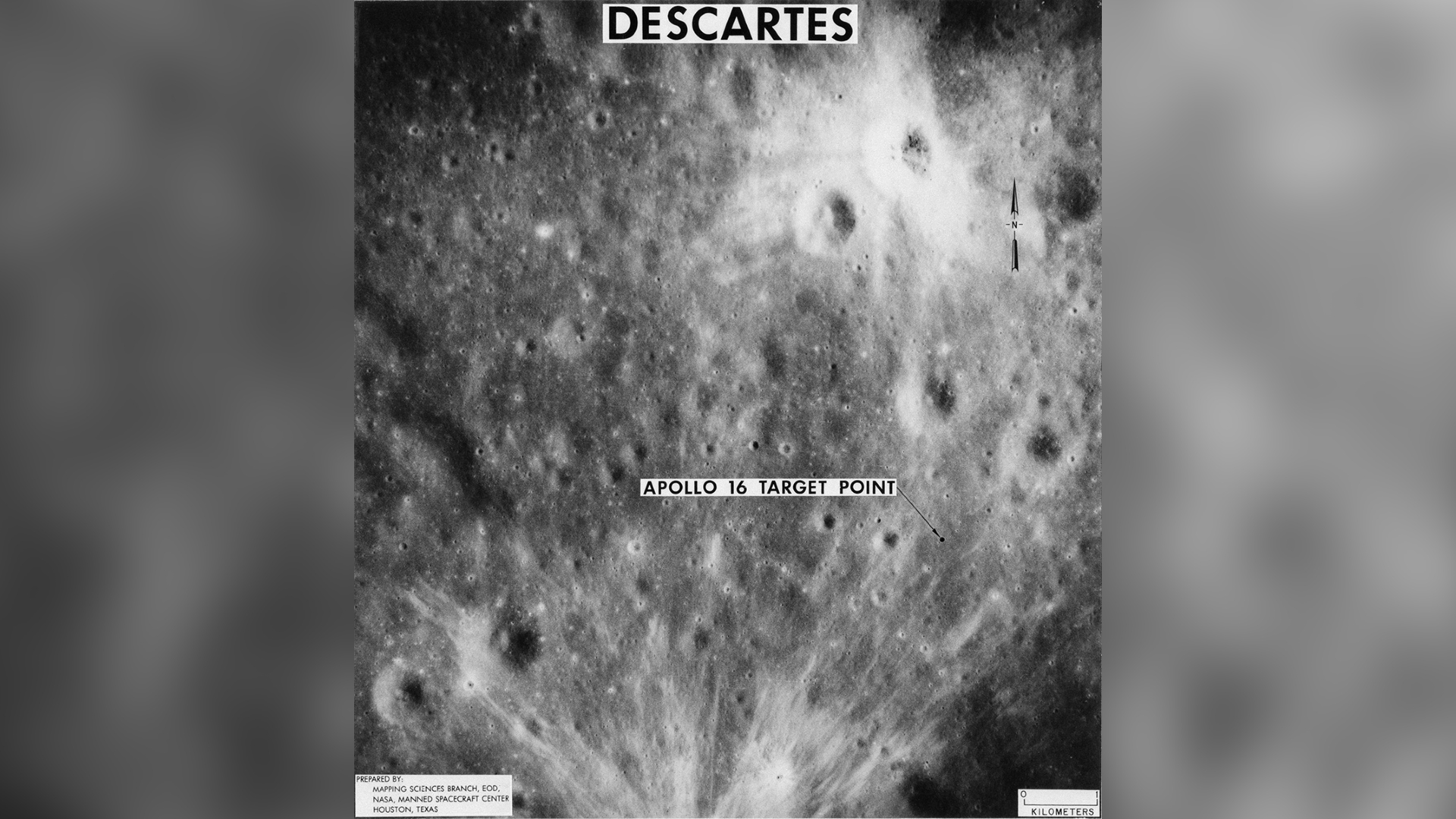
From directly above the Apollo 16 landing site in the Descartes area is clear. Over the image a layout of the suggested landing location for the Apollo 16 Lunar Module. The crew took this image from lunar orbit with a 500mm lens camera.
In the Apollo 16 Lunar Module, called "Orion," astronauts John W. Young, commander; and Charles M. Duke Jr., lunar module pilot; descended to and landed on the Descartes highlands on the moon. During the exploration, astronaut Thomas K. Mattingly II, command module pilot, stayed in the Apollo 16 Command and Service Modules, called "Casper," in orbit.
Geology trip
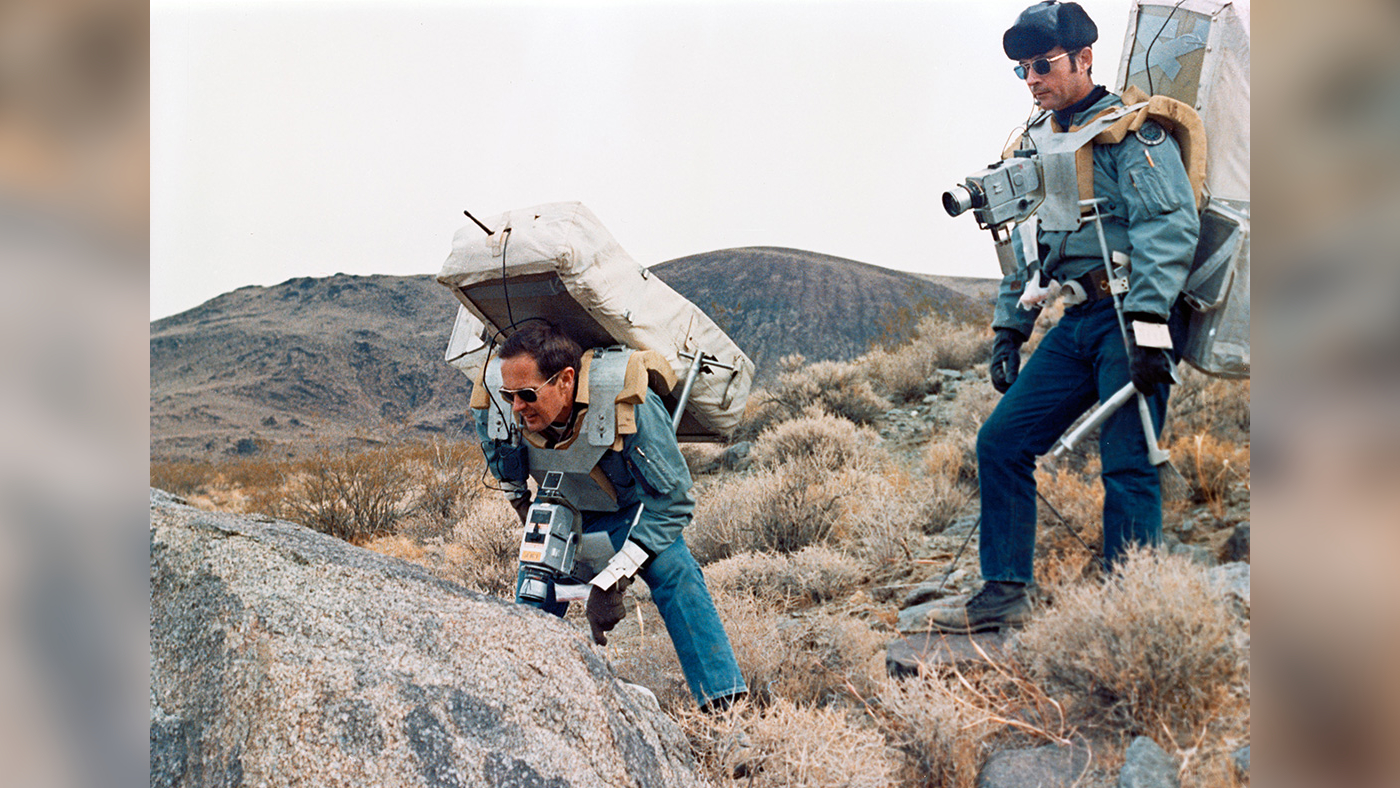
Over November 17-18, 1971, astronauts John W. Young, right, prime crew commander for Apollo 16, and Charles M. Duke Jr., lunar module pilot, took part in a geology field trip to the Coso Range outside Ridgecrest, California to complete exercises along a simulated lunar traverse route. The tasks were completed at the U.S. Naval Ordnance Test Station.
Landing location
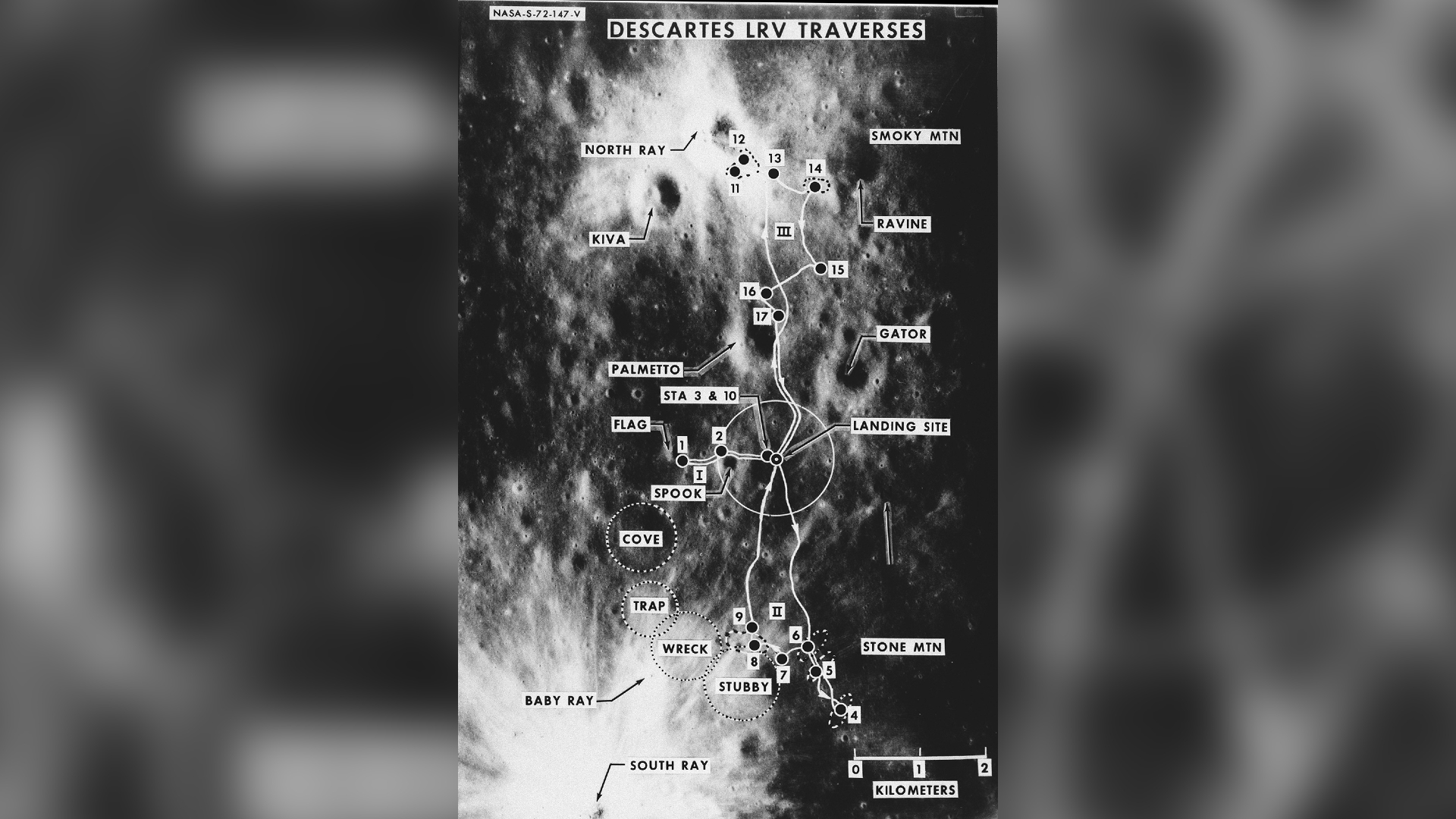
From the Apollo 14 spacecraft, this image of the Descartes area was captured almost vertically. For the Apollo 16 lunar landing mission, an overlay of the planned extravehicular activities, Lunar Roving Vehicle routes and the nicknames of the moons features. Roman numerals reveal EVA numbers and Arabic numbers indicate stations or traverse stops for the vehicle.
Simulations
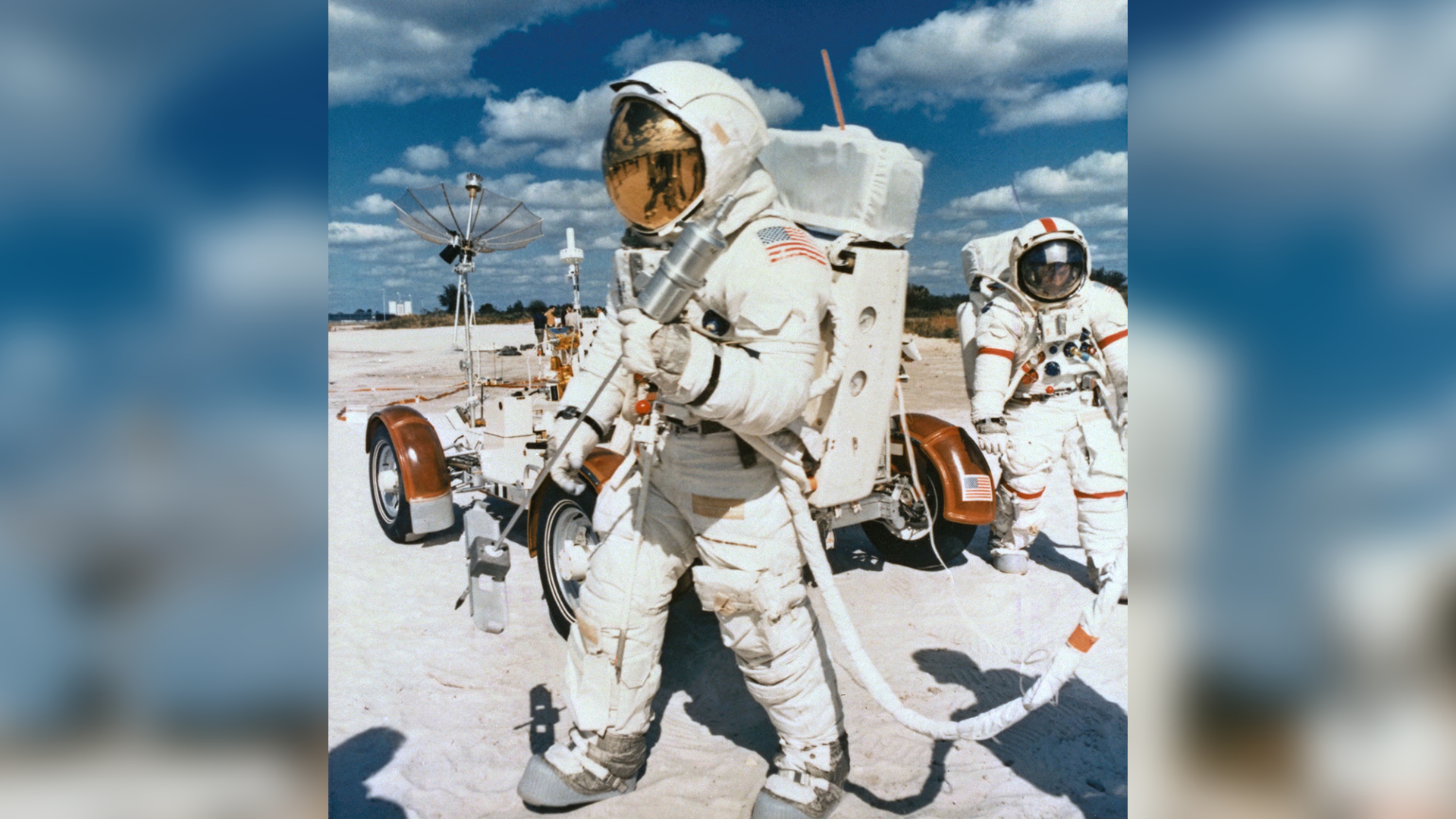
Apollo 16, the fifth NASA Apollo lunar landing mission, touched down in the mountainous highlands region near the Descartes crater. The Apollo 16 lunar landing mission was a three-day mission carrying the self-recording penetrometer experiment, an experiment on lunar soil mechanics. On January 28, 1972, astronauts John W. Young, left, Apollo 16 commander, and Charles M. Duke Jr., lunar module pilot, simulate a lunar traverse. Duke holds a model of the penetrometer.
Underwater training
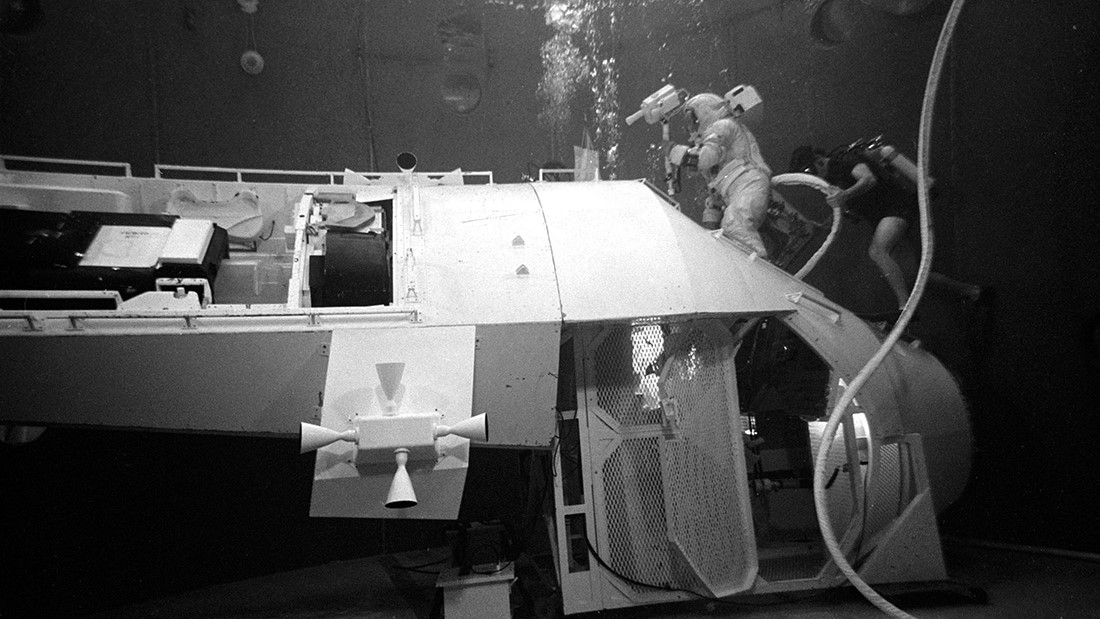
During a December 1, 1971 underwater training to simulate the conditions in space, astronaut Thomas K. Mattingly II, command module pilot of the Apollo 16 lunar landing mission, participates in extravehicular activity exercises in a water facility tank at the Manned Spacecraft Center in Building 5.
Water egress training
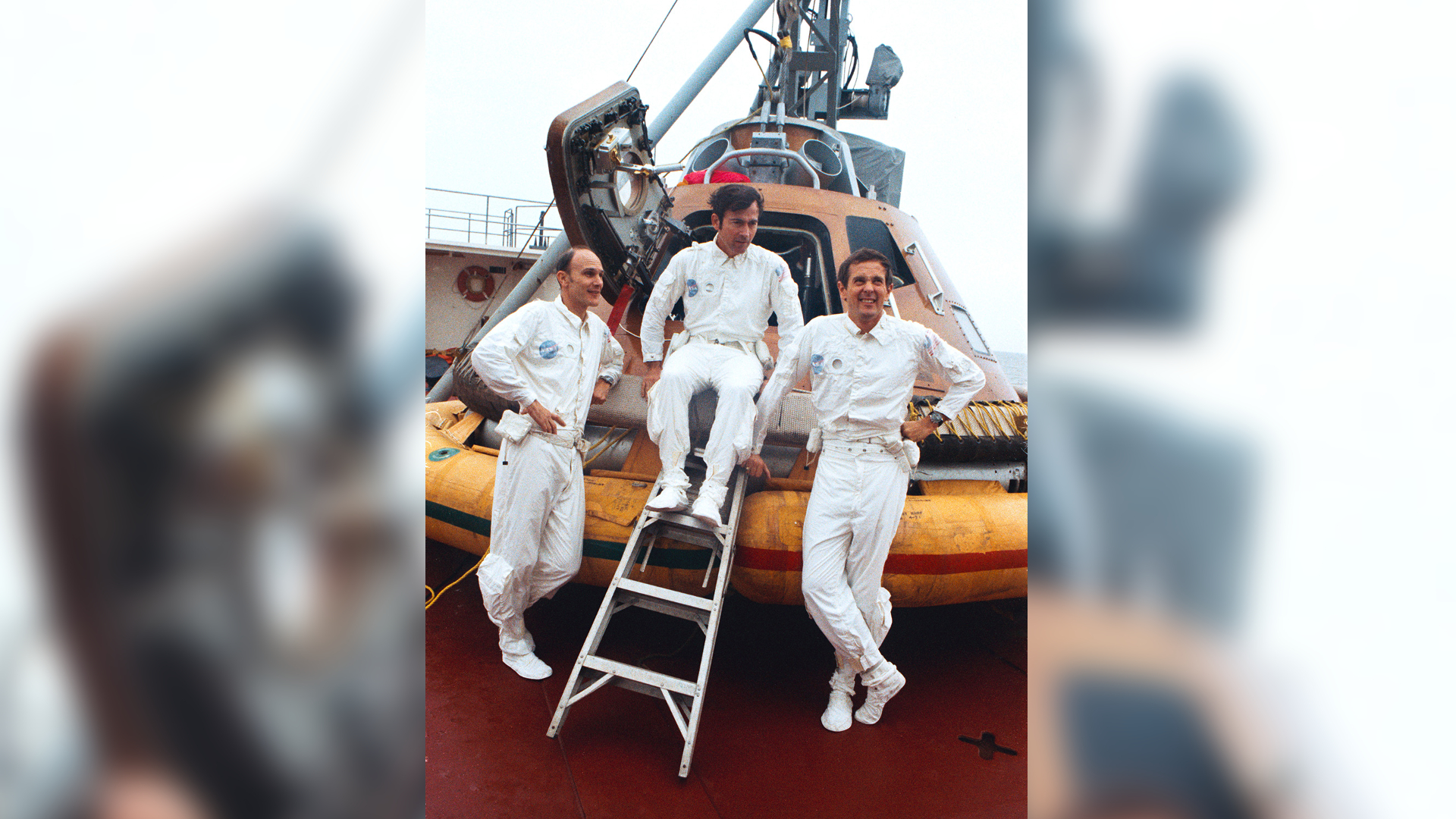
During water egress training in the Gulf of Mexico on February 5, 1972, the Apollo 16 prime crew — from left to right, astronauts Thomas K. Mattingly II, command module pilot; John W. Young, commander; and Charles M. Duke Jr., lunar module pilot — chill on the NASA Motor Vessel Retriever.
Apollo 16 launch
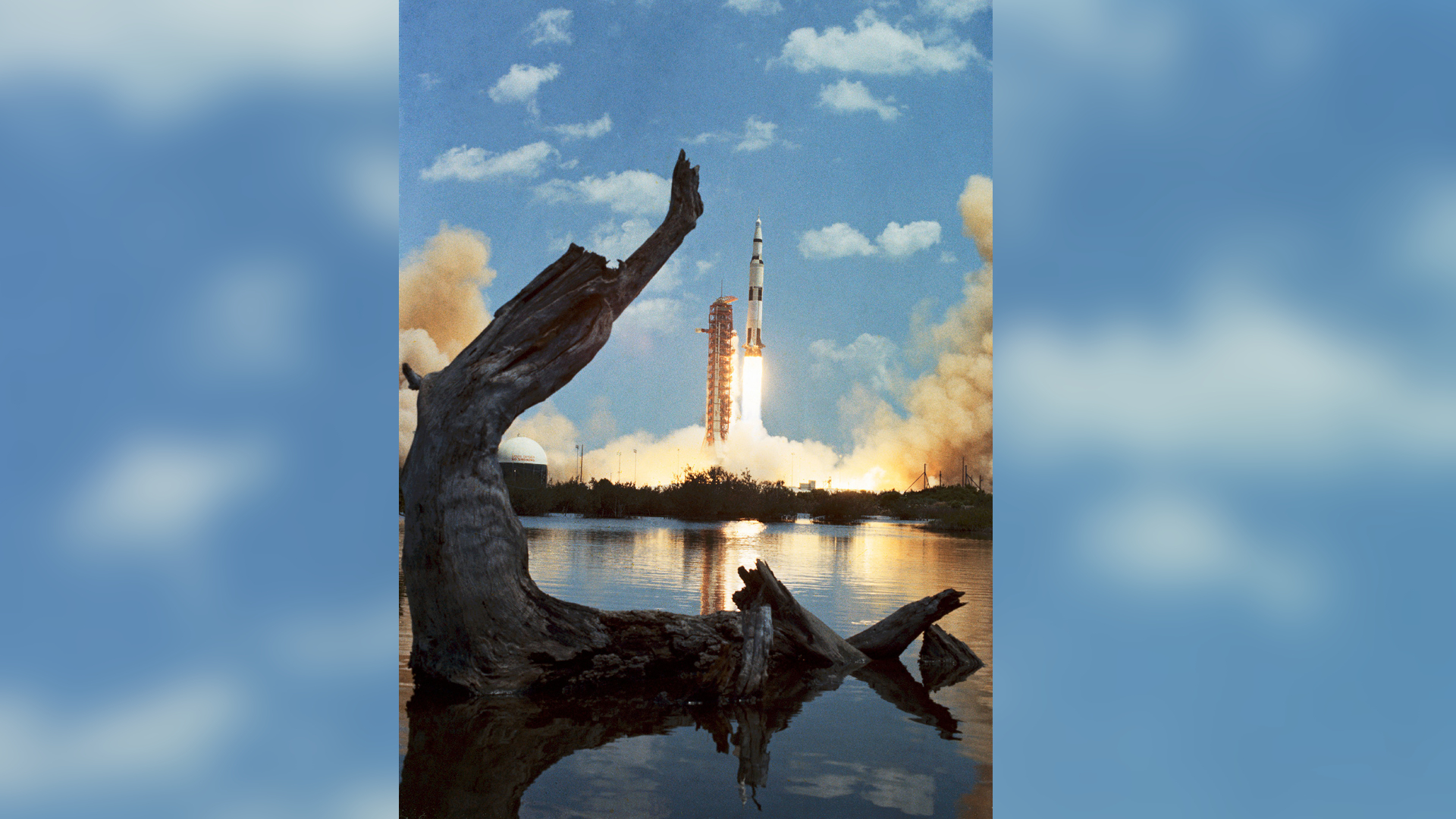
On April 16, 1972, the Apollo 16 space vehicle, standing 363-feel tall, consisting of Spacecraft 113, Lunar Module 11 and Saturn 511, successfully launched from Launch Complex 39, Pad A at Kennedy Space Center, Florida. The Apollo 16 prime crew — astronauts Thomas K. Mattingly II, command module pilot; John W. Young, commander; and Charles M. Duke Jr., lunar module pilot — were part of NASA's fifth lunar landing mission.
Mission Control
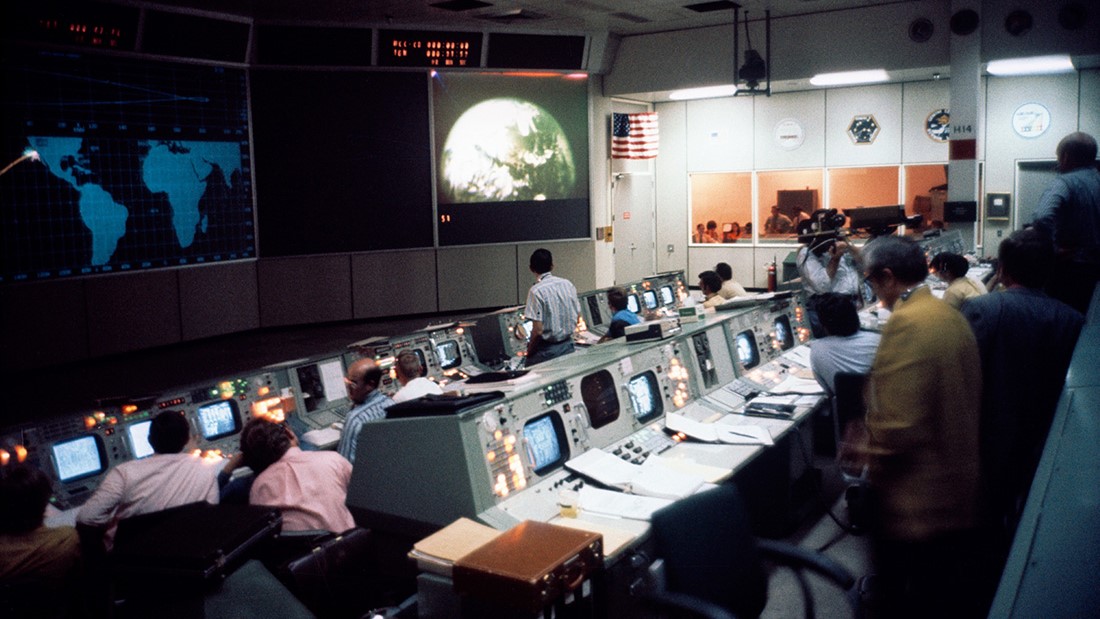
Activity at the Mission Operations Control Room at the Mission Control Center on April 16, 1972, reveals a television transmission from the Apollo 16 spacecraft in transit from Earth to the moon. On the monitor in the background a view of Earth from the spacecraft.
The Blue Marble
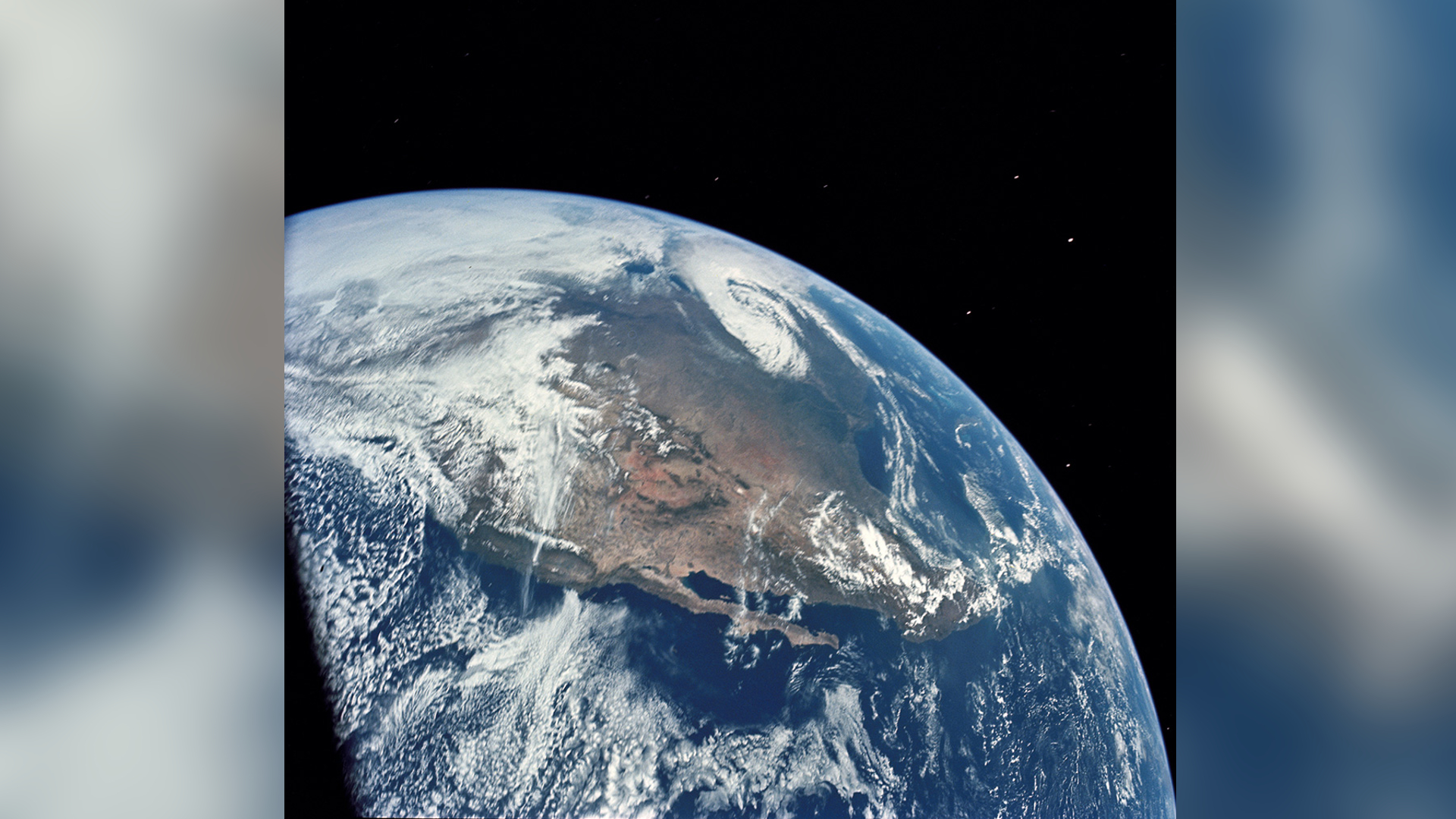
From the Apollo 16 space vehicle, the Apollo 16 astronauts saw Earth this way. Canada and the oceans have a great deal of cloud cover but the United States is almost entirely visible. Two of the Great Lakes and much of the Rocky Mountain Range is clear.
Earthrise
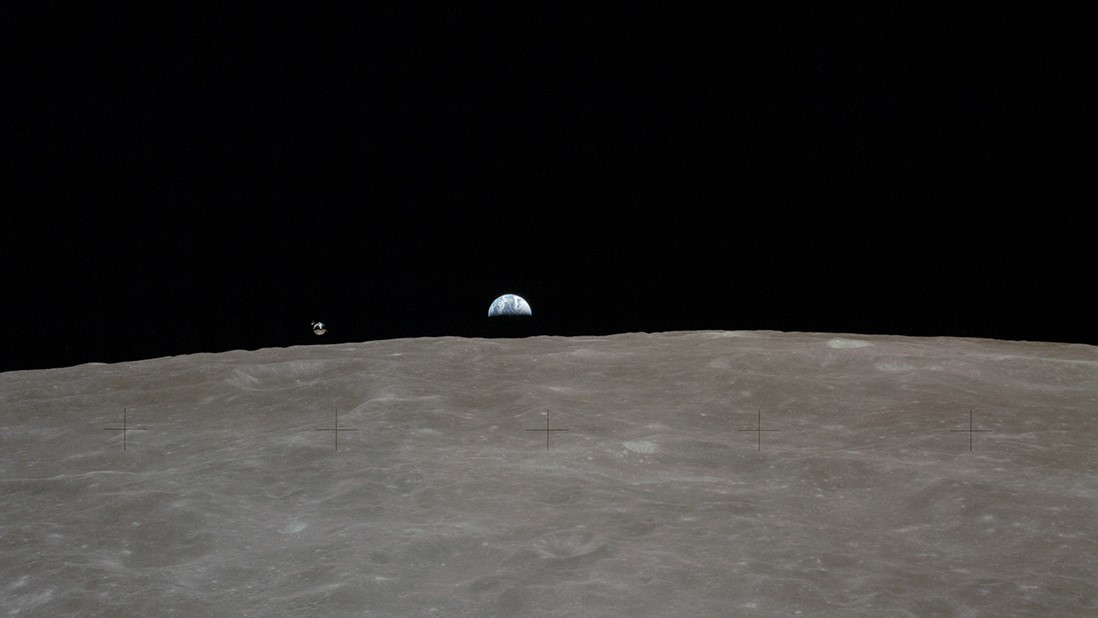
Across the lunar horizon, Earth rises and the Apollo 16 Command and Service Modules, known as "Casper," floats. Astronauts John W. Young, commander, and Charles M. Duke Jr., lunar module pilot, were inside the Lunar Module, known as "Orion," from where this image was taken on April 20, 1972.
The two spacecraft re-joined after the Command and Service Modules, with astronaut Thomas K. Mattingly II, command module pilot, inside, failed to complete the circularization burn.
Above the moon
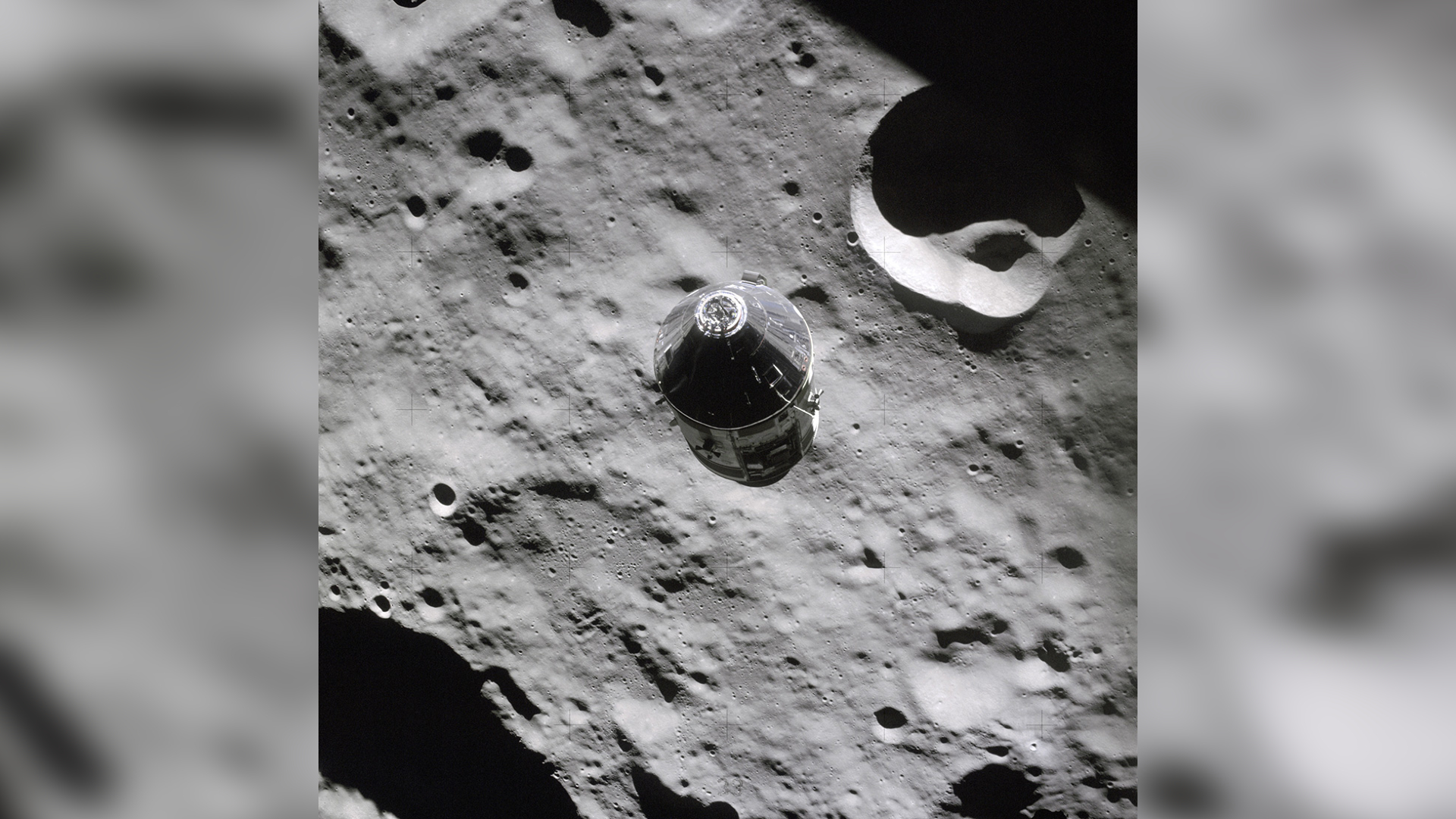
The Apollo 16 Lunar Module captured this image of the Command and Service Modules from above just after undocking, with the lunar surface in the background.
The two spacecrafts were on the farside of the moon so they were without communications briefly until they returned to Earth's side.
Craters craters everywhere
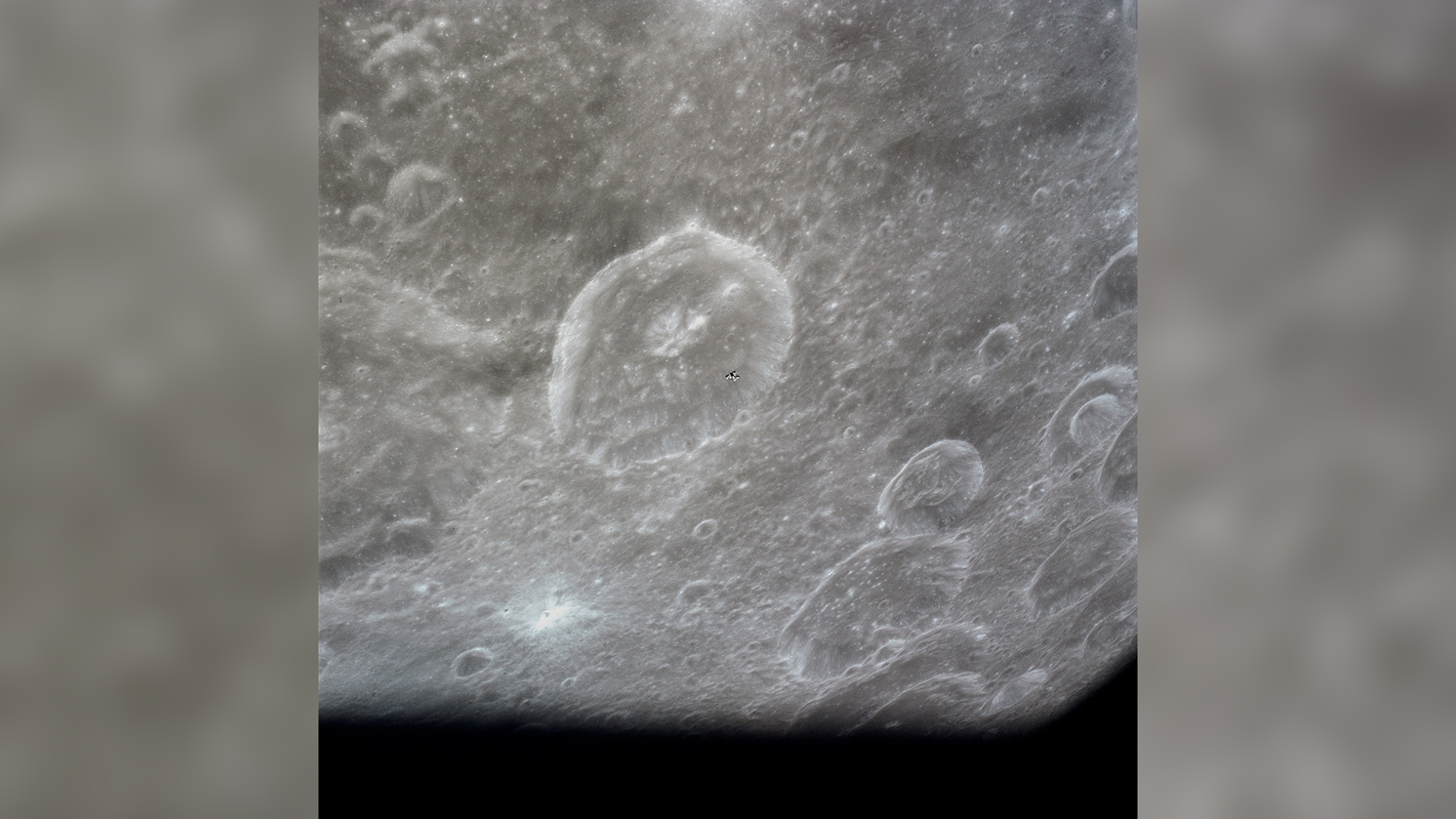
On April 23, 1972, the Apollo 16 Lunar Module ascent stage, containing astronauts John W. Young and Charles M. Duke Jr., rejoined the Command and Service Modules, with astronaut Thomas K. Mattingly II, in lunar orbit. Below the Lunar Module is the Crater Schubert B which is at the western edge of Smyth's Sea.
Farside crater
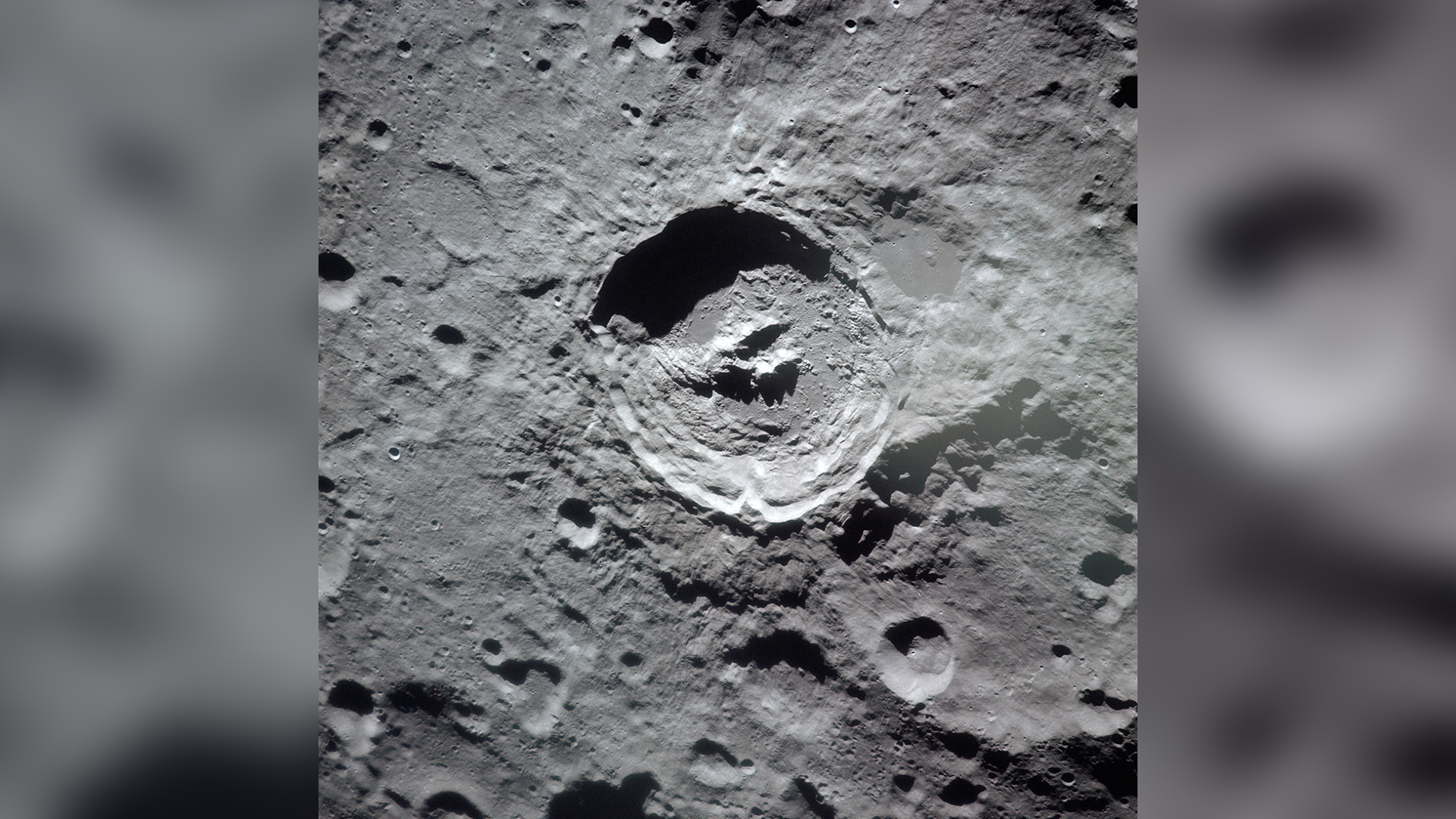
During an orbit around the farside of the moon the Apollo 16 spacecraft passed King Crater. Inside the crater strange mountainous features are visible.
Roadtrip
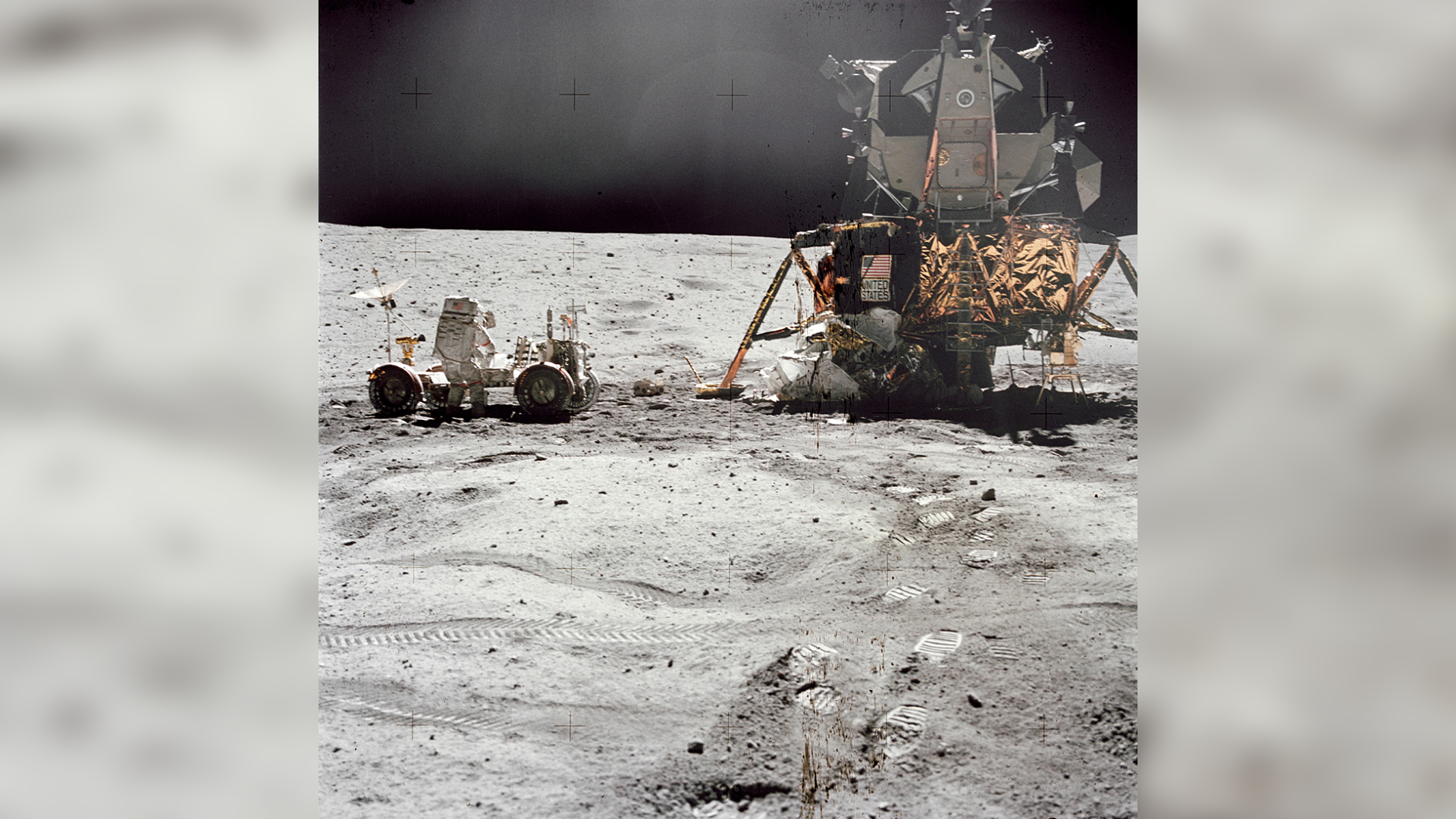
During the April 21, 1972 extravehicular activity, the first of the mission, astronaut John W. Young, Apollo 16 lunar landing mission commander, prepares the Lunar Roving Vehicle for traversing the surface of the moon. Young and Charles M. Duke Jr., lunar module pilot, readied the Apollo Lunar Surface Experiments Package.
The Ultraviolet Camera/Spectrometer can be seen to the right of the Lunar Module ladder and a section of protective, thermal foil lay under the U.S. flag on the craft. Astronaut Thomas K. Mattingly II remained aboard the Apollo 16 Command and Service Modules during their lunar adventure.
Apollo 16 Lunar Module shadow
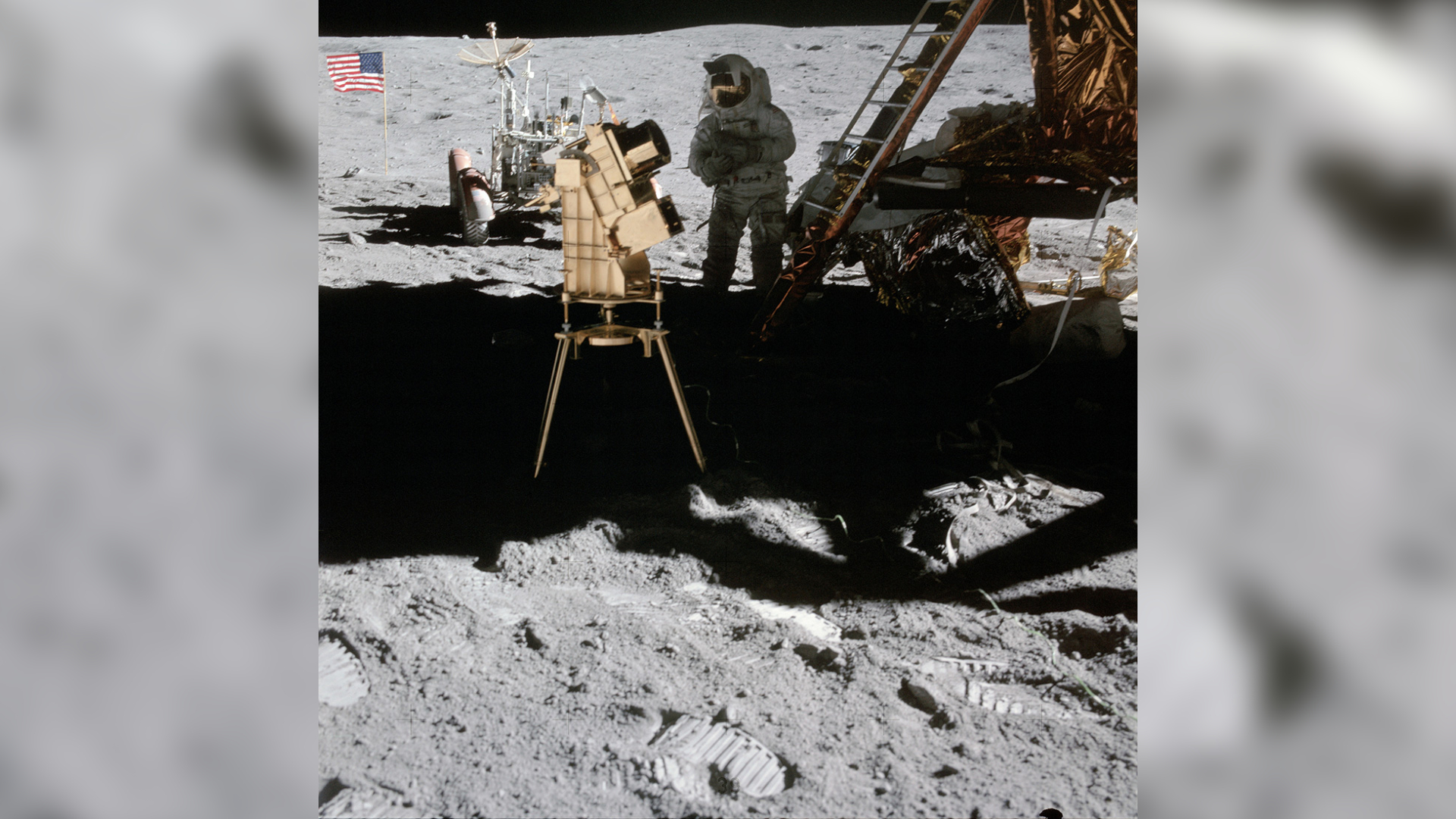
The Apollo 16 Lunar Module casts a big shadow across the moon's surface and astronaut Charles M. Duke Jr., lunar module pilot, can be seen in it. In the foreground of the image, the Ultraviolet camera operates.
Astronaut John W. Young, commander, snapped this image during the second extravehicular activity of the Apollo 16 lunar landing mission. Using the Ultraviolet camera, over 180 images and spectra in far-ultraviolet light were collected.The images revealed clouds of hydrogen and other gases as well as several thousand stars.
Plum Crater
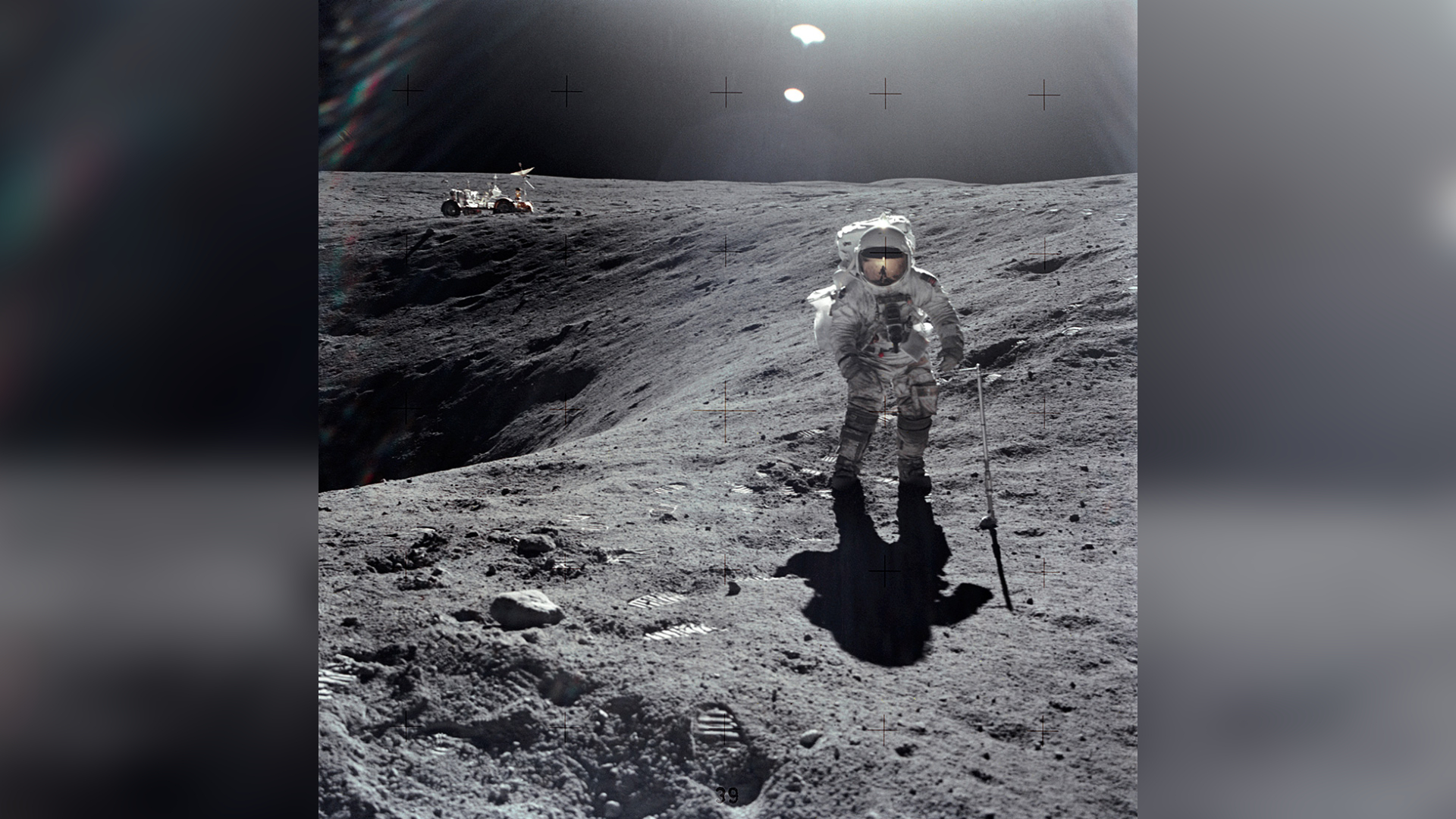
At the Descartes landing site during the Apollo 16 mission's first EVA, astronaut Charles M. Duke Jr., lunar module pilot, collects lunar samples at Station No. 1. Astronaut John W. Young, commander, captured this image of Duke near Plum Crater.
Sample gathering
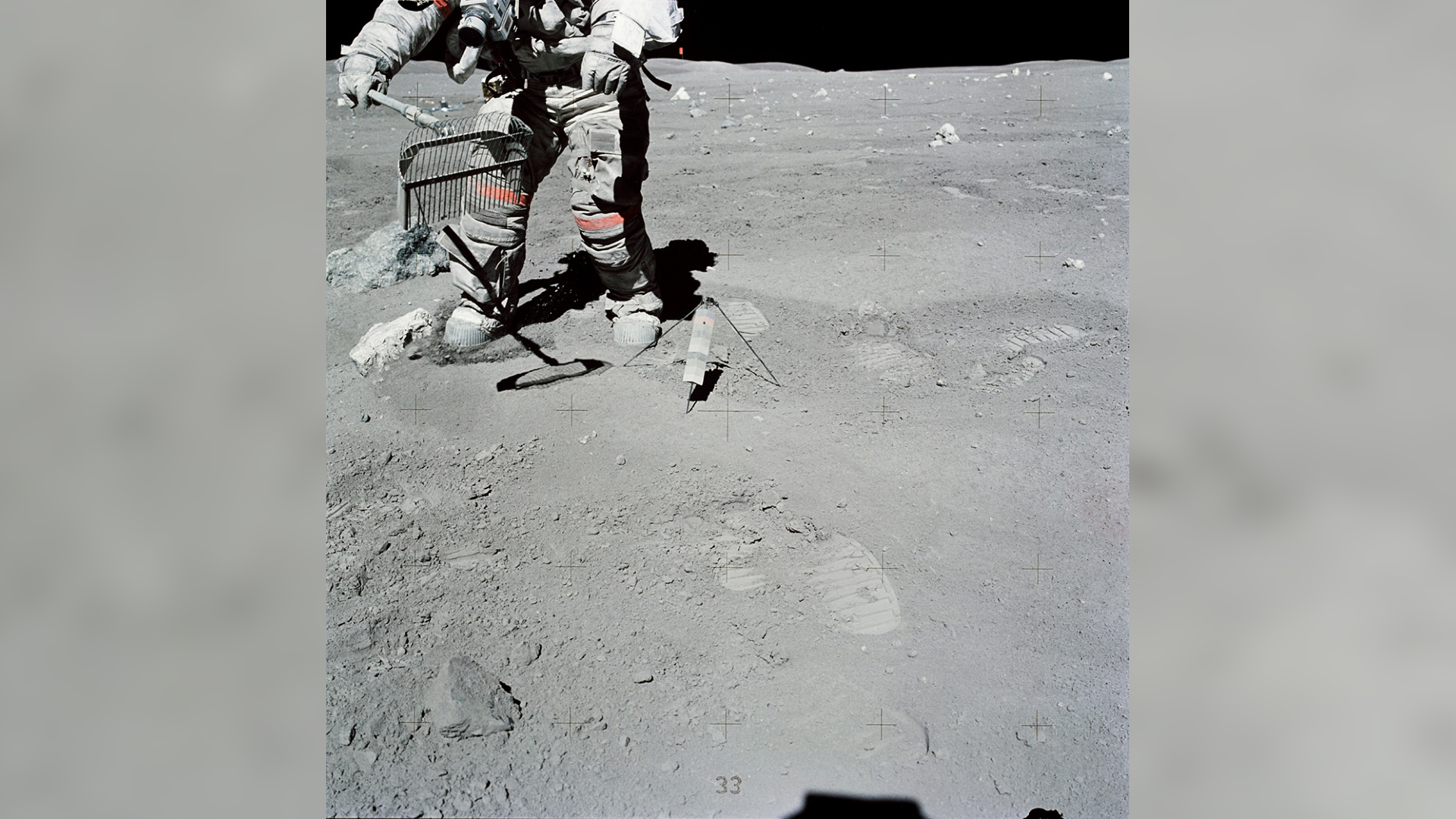
At the North Ray Crater geological site, astronaut John W. Young gathers samples during the third and final Apollo 16 lunar landing mission's extravehicular activity.
Young uses a rake and a gnomon. His Extravehicular Mobility Unit is extremely dirty.
Stone Mountain
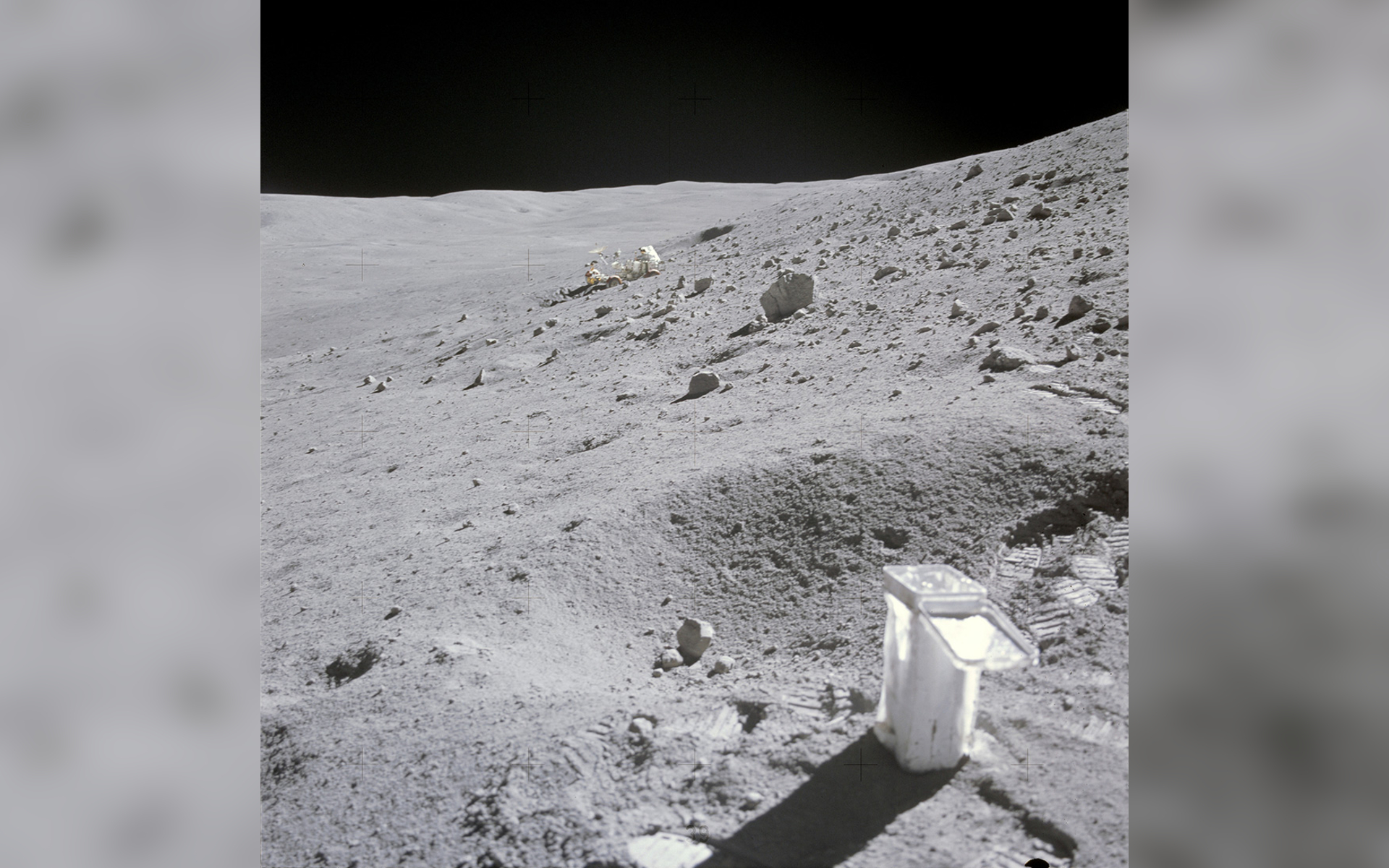
On the incline of Stone Mountain, the Lunar Roving Vehicle sits in what seems to be a deep lunar depression.
During the second Apollo 16 extravehicular activity on April 22, 1972, astronauts John W. Young, commander, and Charles M. Duke, Jr., gathered samples and images around the Descartes landing site.
Soil samples
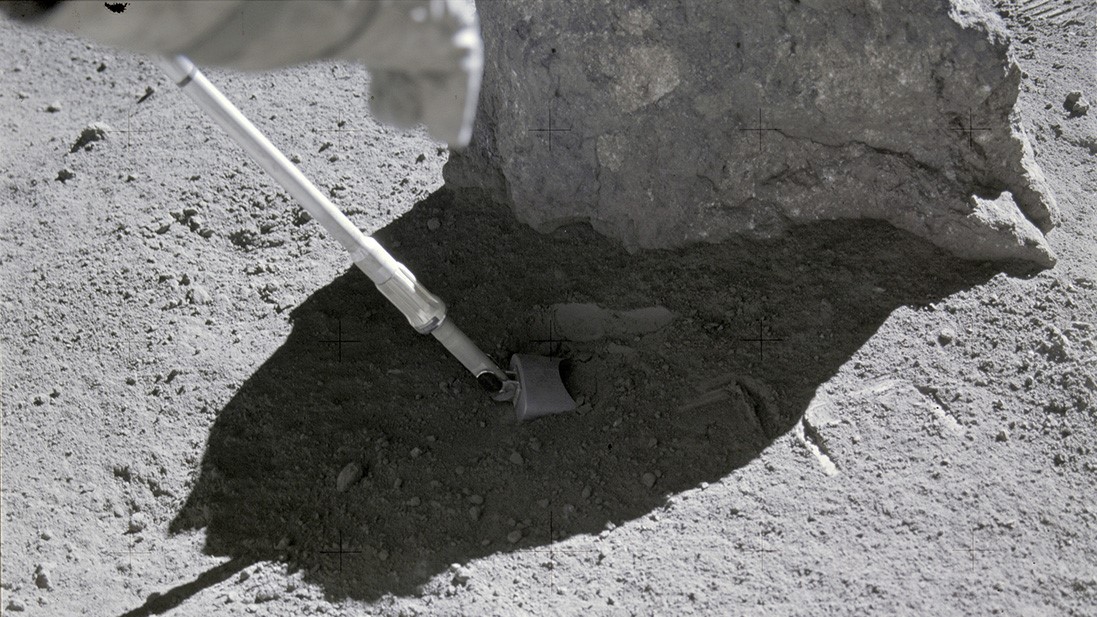
During the second EVA of the Apollo 16 mission, an Apollo 16 crewman retrieves soil samples from the moon's surface in the shadow of a small lunar boulder at the Descartes landing site. The sample was derived from dirt from beneath the boulder.
Sample collection Plum Crater
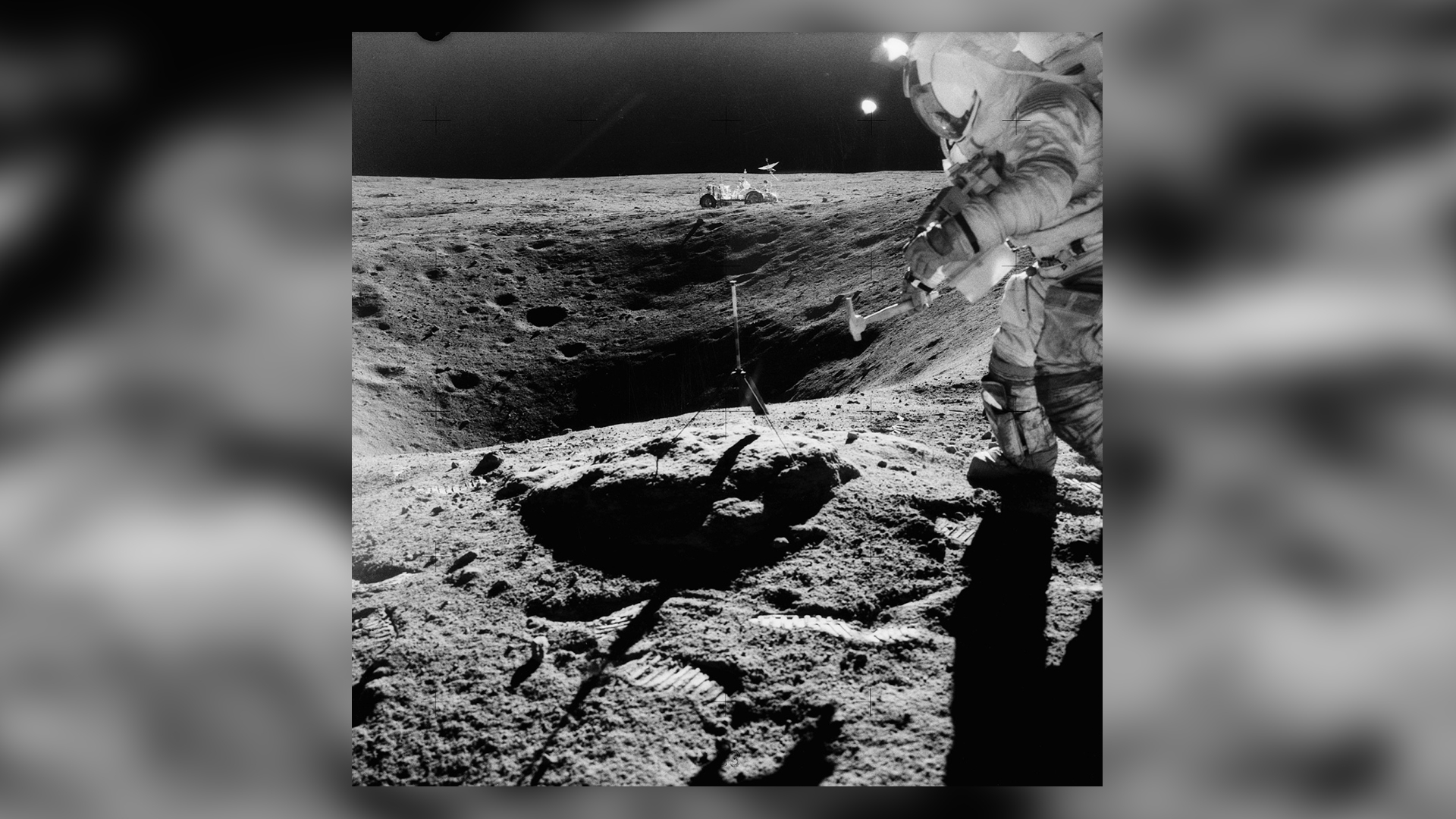
Collecting lunar samples at the rim of Plum Crater, astronaut John W. Young, commander of the Apollo 16 lunar landing mission, is photographed holding a hammer by astronaut Charles M. Duke, Jr., lunar module pilot.
The astronauts gathered a chip sample of the small boulder at center. On the far edge of the crater the Lunar Roving Vehicle is visible. The gnomon, seen near the boulder, is a tool used as a photographic reference to establish vertical sun angle, scale and lunar color.
"Moon"- buggy
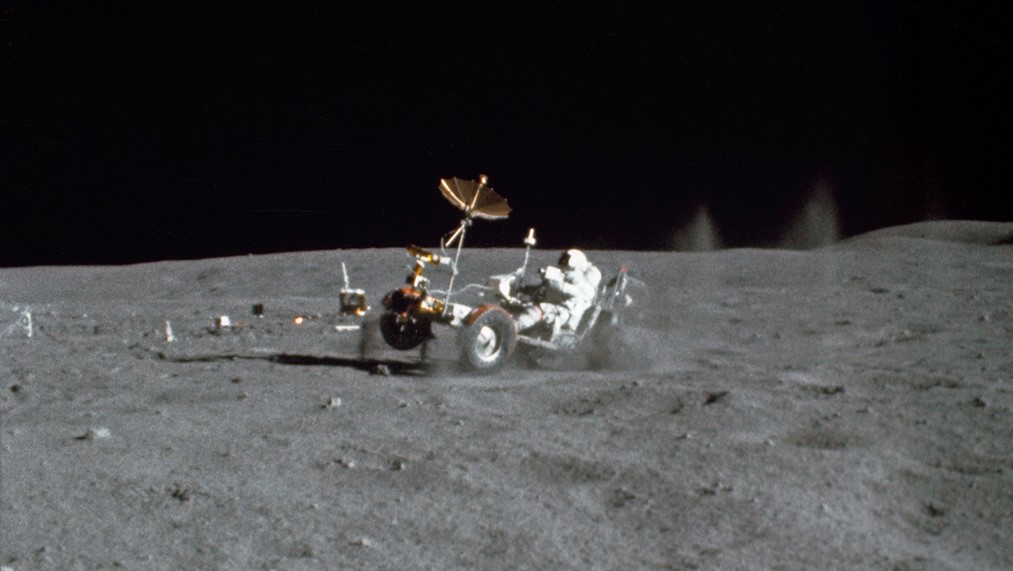
On the lunar surface, astronaut John W. Young gives the Lunar Roving Vehicle a speed workout during the first of three Apollo 16 extravehicular activities at the Descartes landing site.
The image comes from a frame of motion picture film taken by astronaut Charles M. Duke, Jr., holding a 16mm Maurer camera.
Final EVA
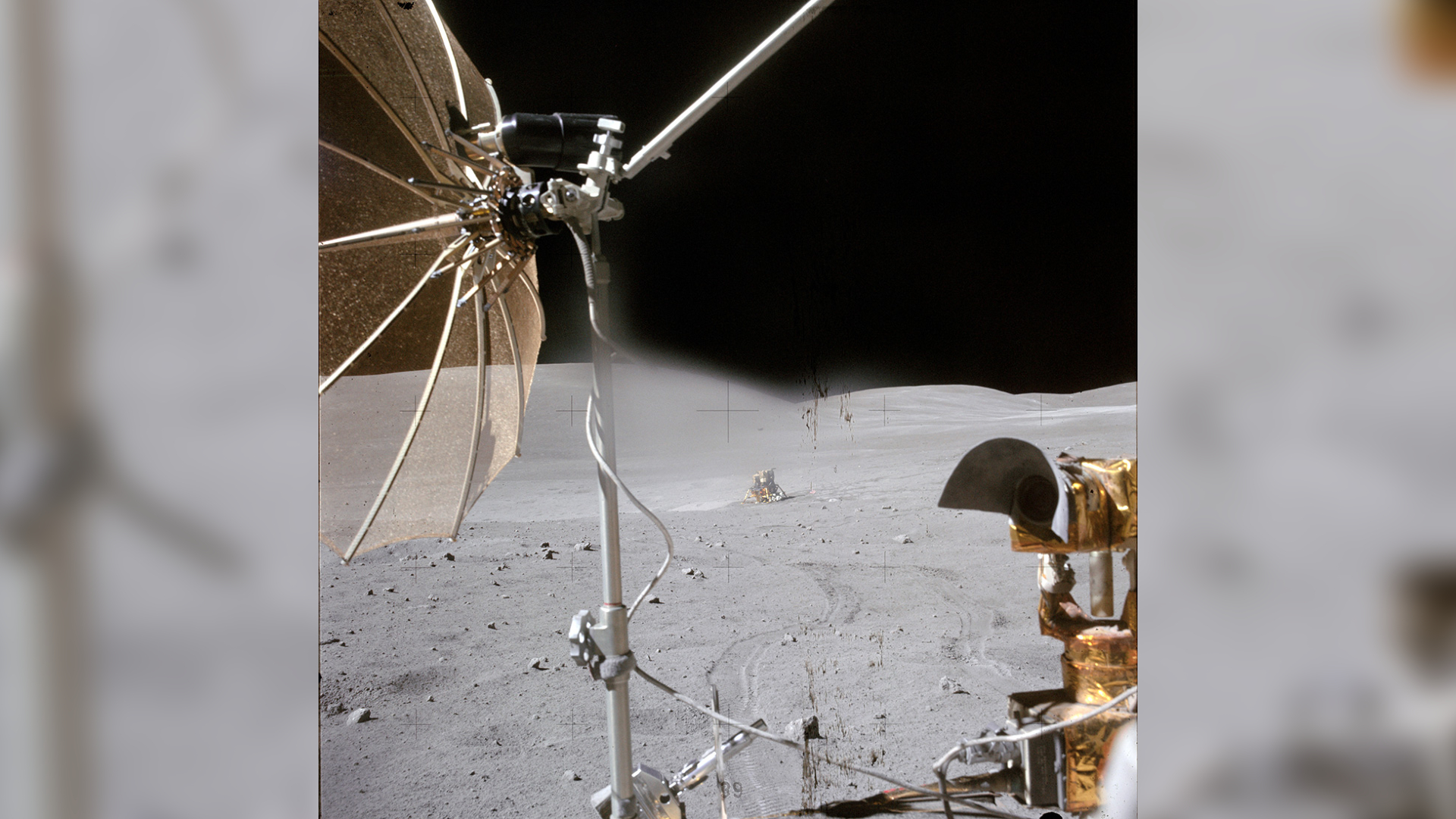
As the third and final extravehicular activity of the Apollo 16 lunar landing mission came to an end, astronauts John W. Young, commander, and Charles M. Duke Jr., lunar module pilot, traversed the lunar service back to the Lunar Module and snapped this image of the moon's surface.
In the center of the image, the Lunar Module sits "in the only flat place around," according to Young. In the background Stone Mountain stretches across half the horizon. In the foreground of the image the high gain antenna and the RCA television camera on the Lunar Roving Vehicle are visible.
Lunar boulder investigation
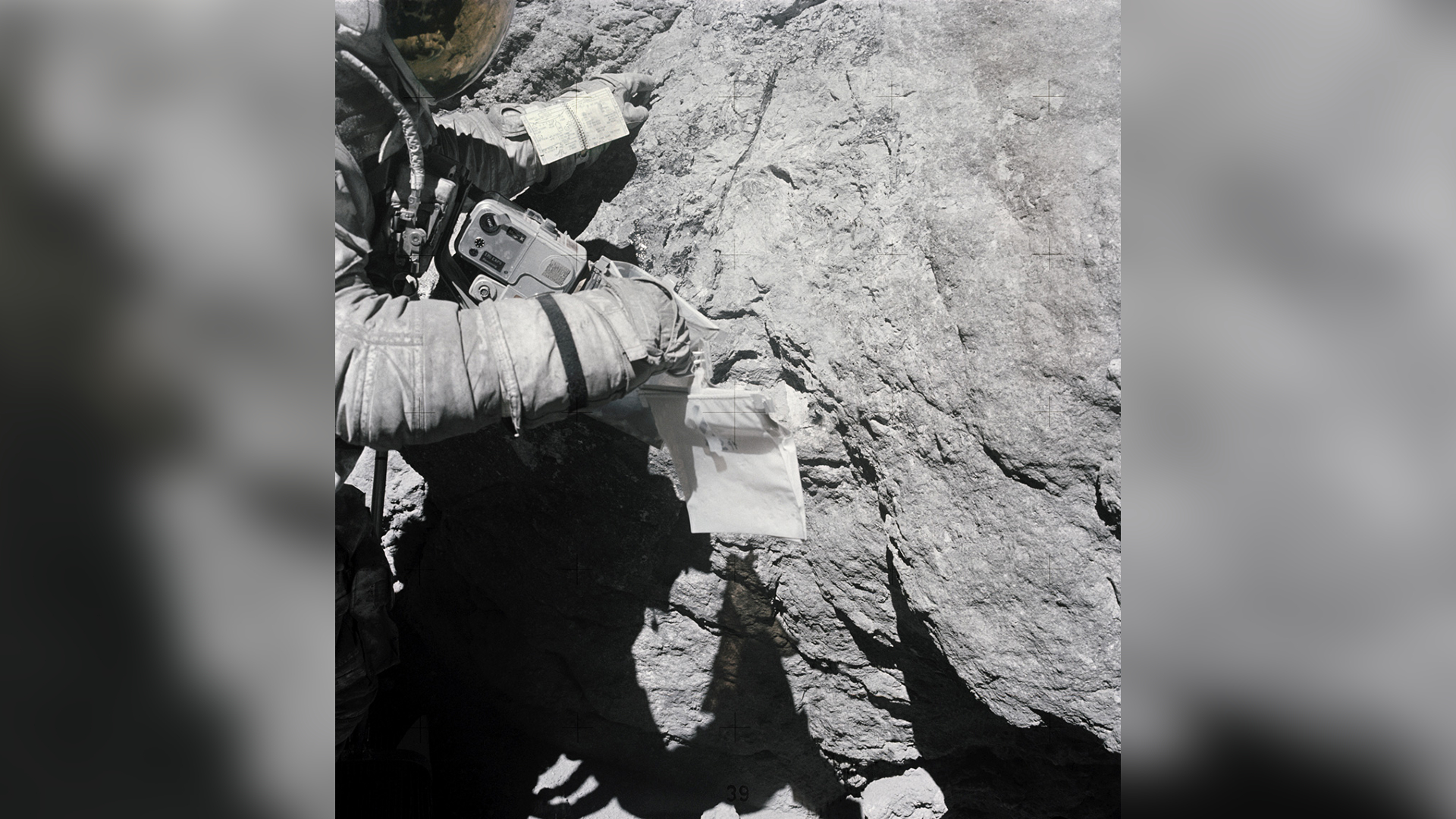
On April 23, 1972, during the third EVA of the Apollo 16 lunar landing mission astronaut Charles M. Duke Jr., lunar module pilot, takes samples and investigates a large lunar boulder at North Ray Crater near the Descartes landing site. While astronaut John W. Young, commander, took this image, a 70mm Hasselblad camera is visible strapped to Duke's chest.
Salute
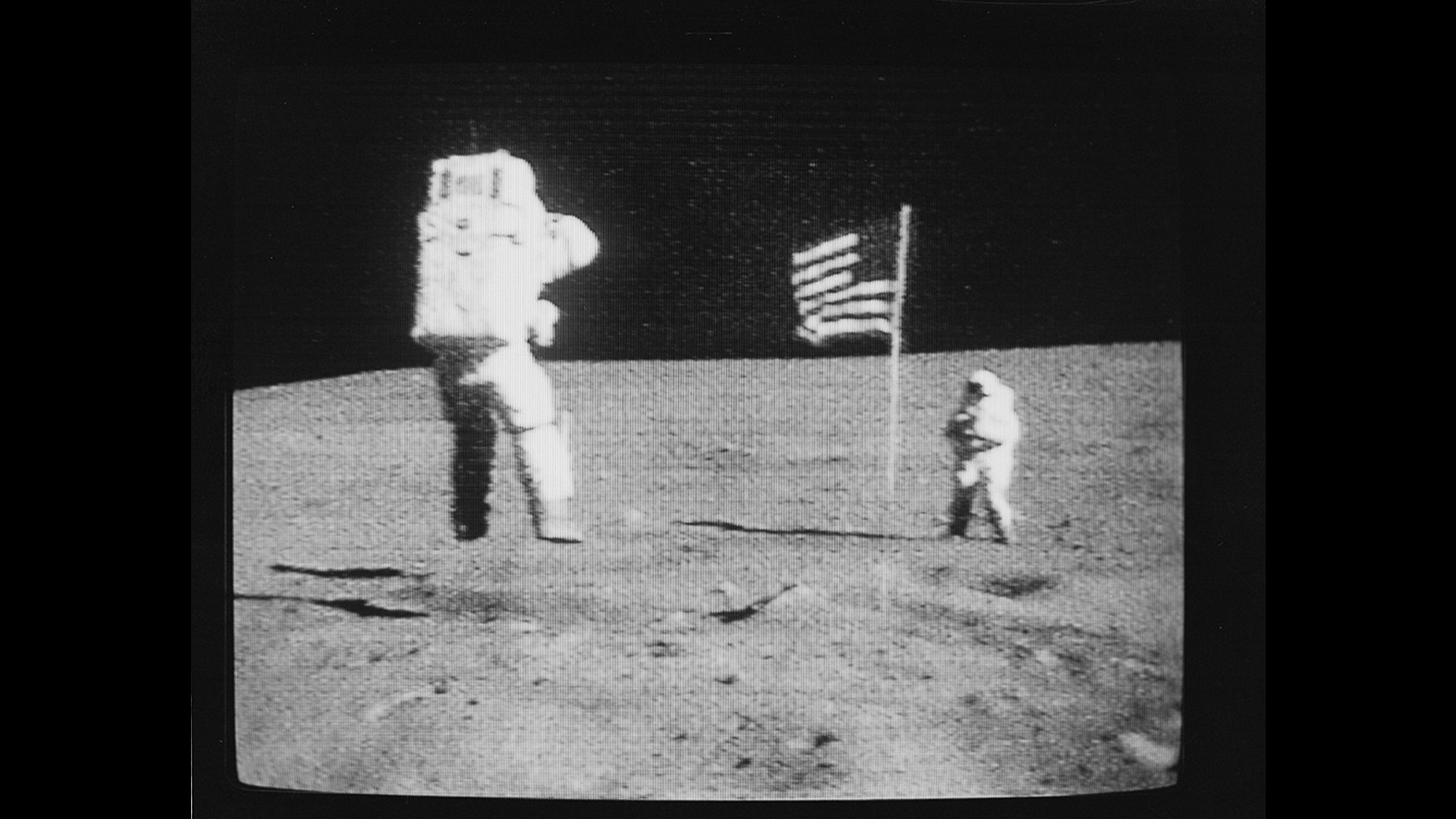
On April 21, 1972 during the first EVA of NASA's fifth lunar landing mission, astronaut John W. Young, commander of the Apollo 16 mission, salutes the United States flag while jumping from the moon's surface.
The image is taken from a color television transmission made by the color TV camera on the Lunar Roving Vehicle. Beside the flag astronaut Charles M. Duke, Jr., stands.
U.S. flag salute
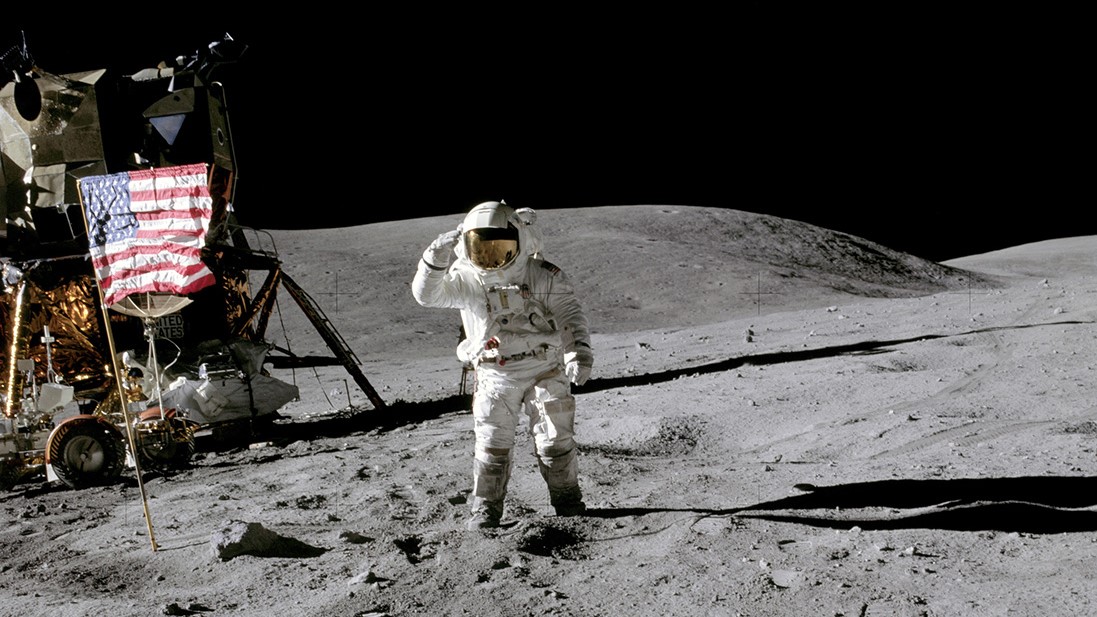
In the background of this April 21, 1972 image, Stone Mountain crosses most of the horizon. Front and center, astronaut Charles M. Duke, Jr., Apollo 16 lunar module pilot, salutes the U.S. flag. To the right of Duke, the Lunar Module and Lunar Roving Vehicle stand.
Lunar surface panorama
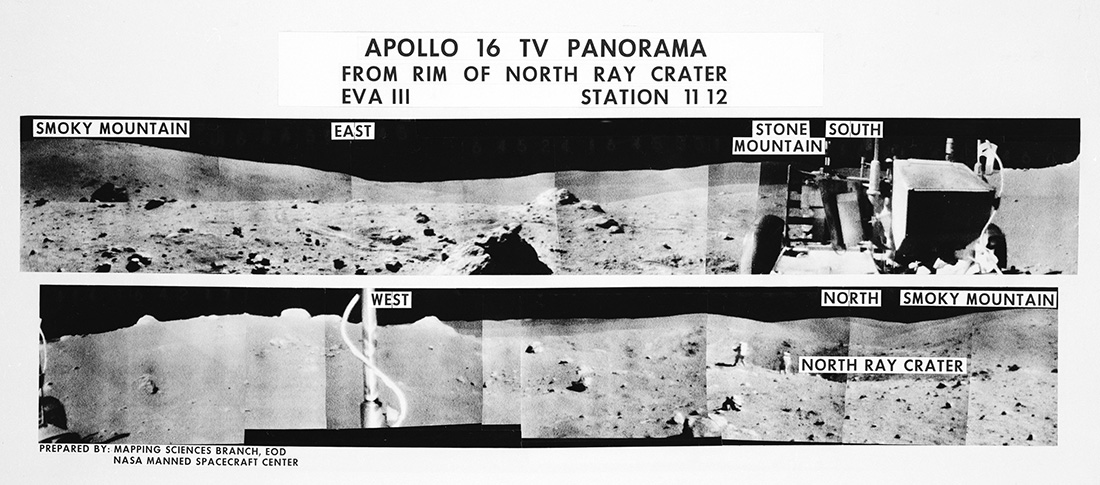
From the rim of North Ray Crater, at Stations 11-12, the color RCA TV camera on the Lunar Roving Vehicle captured this 360-degree field of view of the Apollo 16 lunar landing mission landing site at Descartes. The image was captured during the mission's third and final EVA of the Apollo 16 mission.
Notations on the image identify directions and key lunar terrain features. Astronauts John W. Young and Charles M. Duke Jr., can be seen in one of the frames. The camera itself was controlled remotely from the Mission Control Center console.
Lunar surface experiments
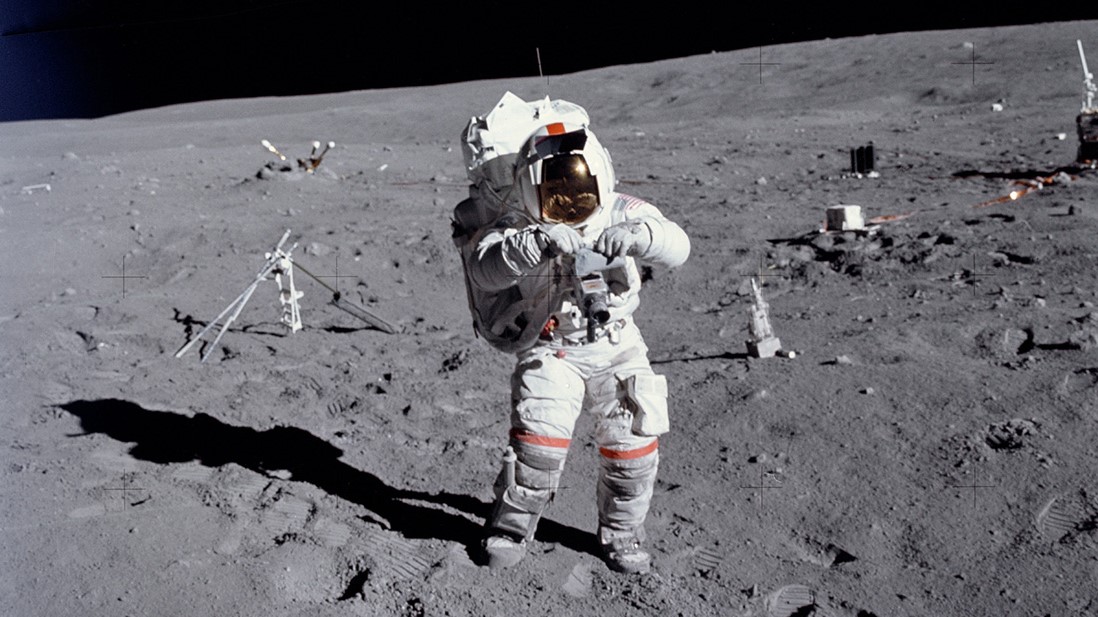
At the Descartes landing site on April 21, 1972, during the first of three extravehicular activities, the Apollo Lunar Surface Experiments Package was deployed. Astronaut Charles M. Duke, Jr., lunar module pilot, photographed astronaut John W. Young, commander, at the site.
The modules of the ALSEP — the lunar surface drill to the right, the drill's rack and bore stems to the left, the three-sensor Lunar Surface Magnetometer on the rear left, the Radioisotope Thermoelectric Generator, Heat Flow Experiment and central station — are scattered throughout the background.
Scenic view
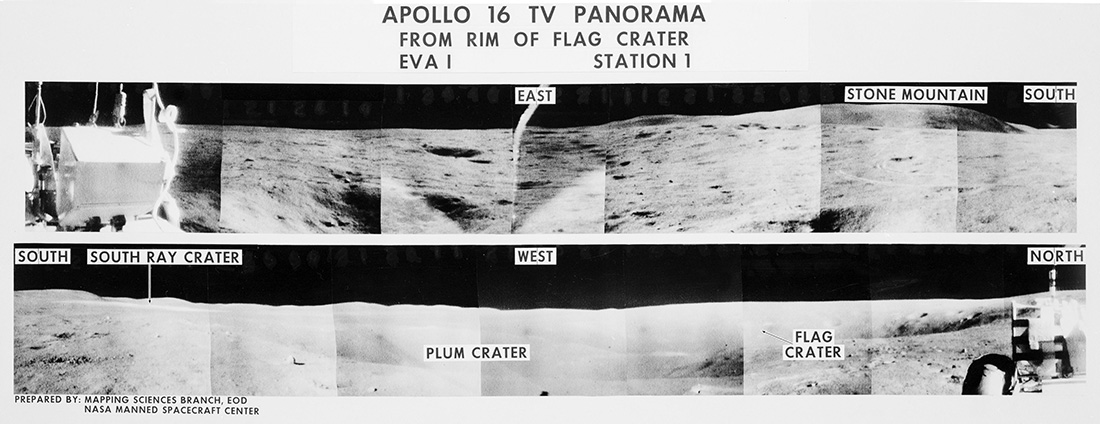
From another position at Station 1 on the rim of Flag Crater, camera mounted on the Lunar Roving Vehicle, captured antlers 360-degree field of view of the Descartes landing site for the Apollo 16 mission. Notations on the image portray direction and the location of key lunar terrain features.
Earth in enhanced color
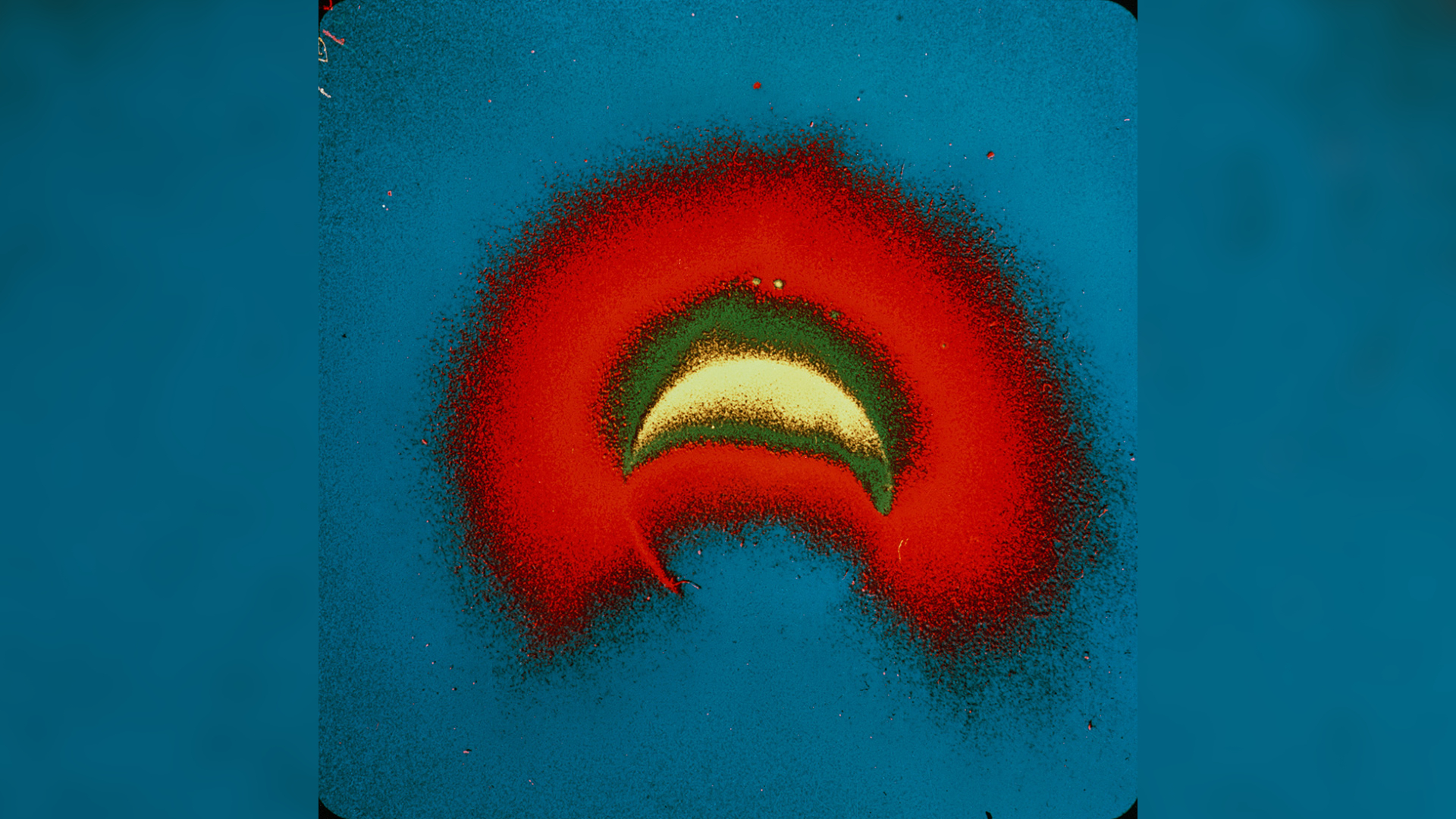
The original photo of Earth used for this color enhanced image was taken by astronaut John W. Young, Apollo 16 commander, using the UV camera created by the Naval Research Laboratory in Washington, D.C. The geocoronoa — a halo of low density hydrogen surrounding Earth — is produced in far ultraviolet colors.
The artificial red represents the faint hydrogen glow. At the lower left, the spike shows auroral activity at the south magnetic pole. The black sky around Earth is shown in the blue background.
Hydrogen halo
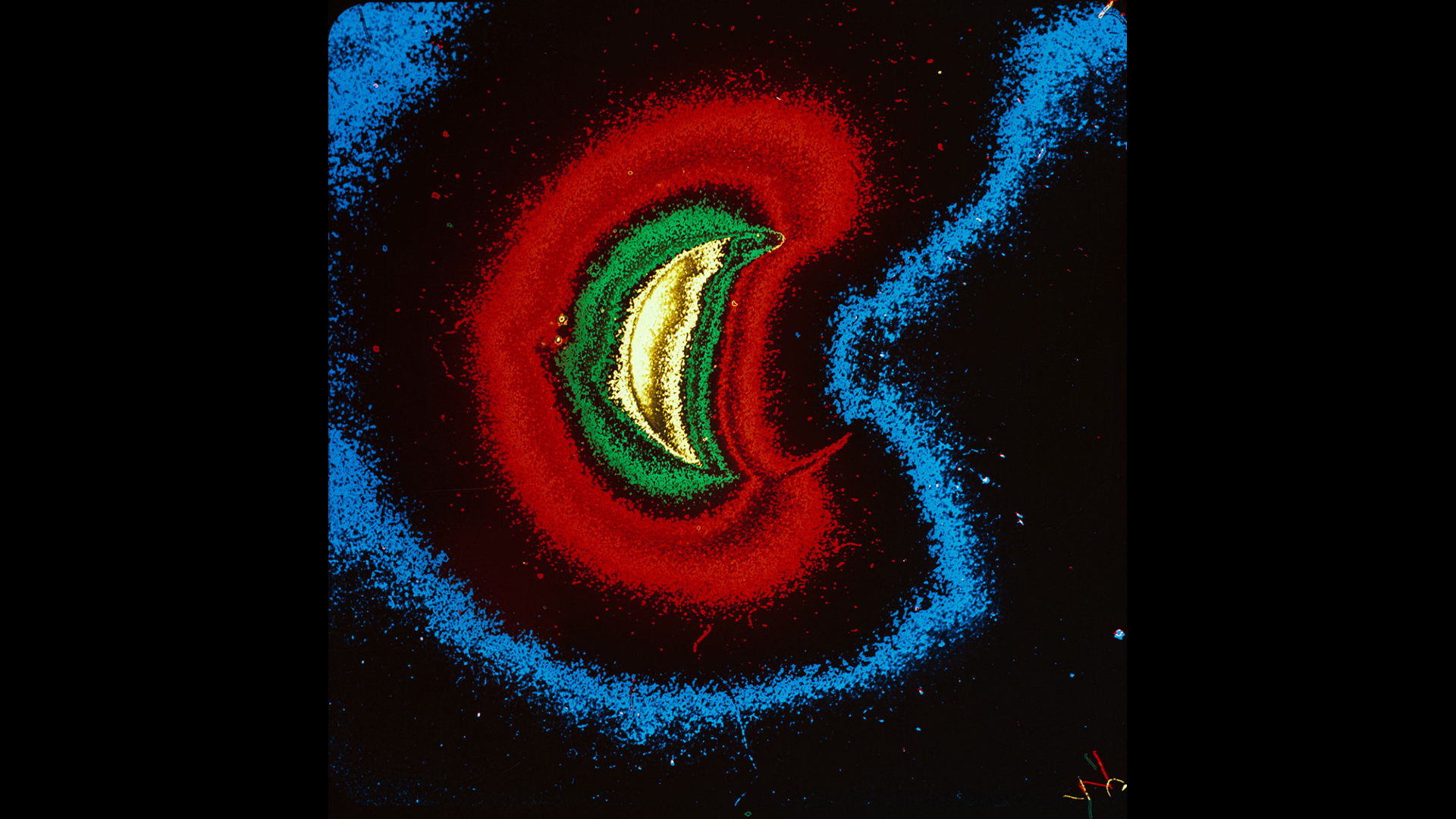
The UV camera produced this ultra-violet photograph of the geocorona — a halo of low density hydrogen around Earth — on April 21, 1972. The effect is brighter on the left side because the sun is shining from that direction.
Astronaut John W. Young operated the camera which was designed and build by the Naval Research Laboratory in Washington, D.C.
Lunar liftoff
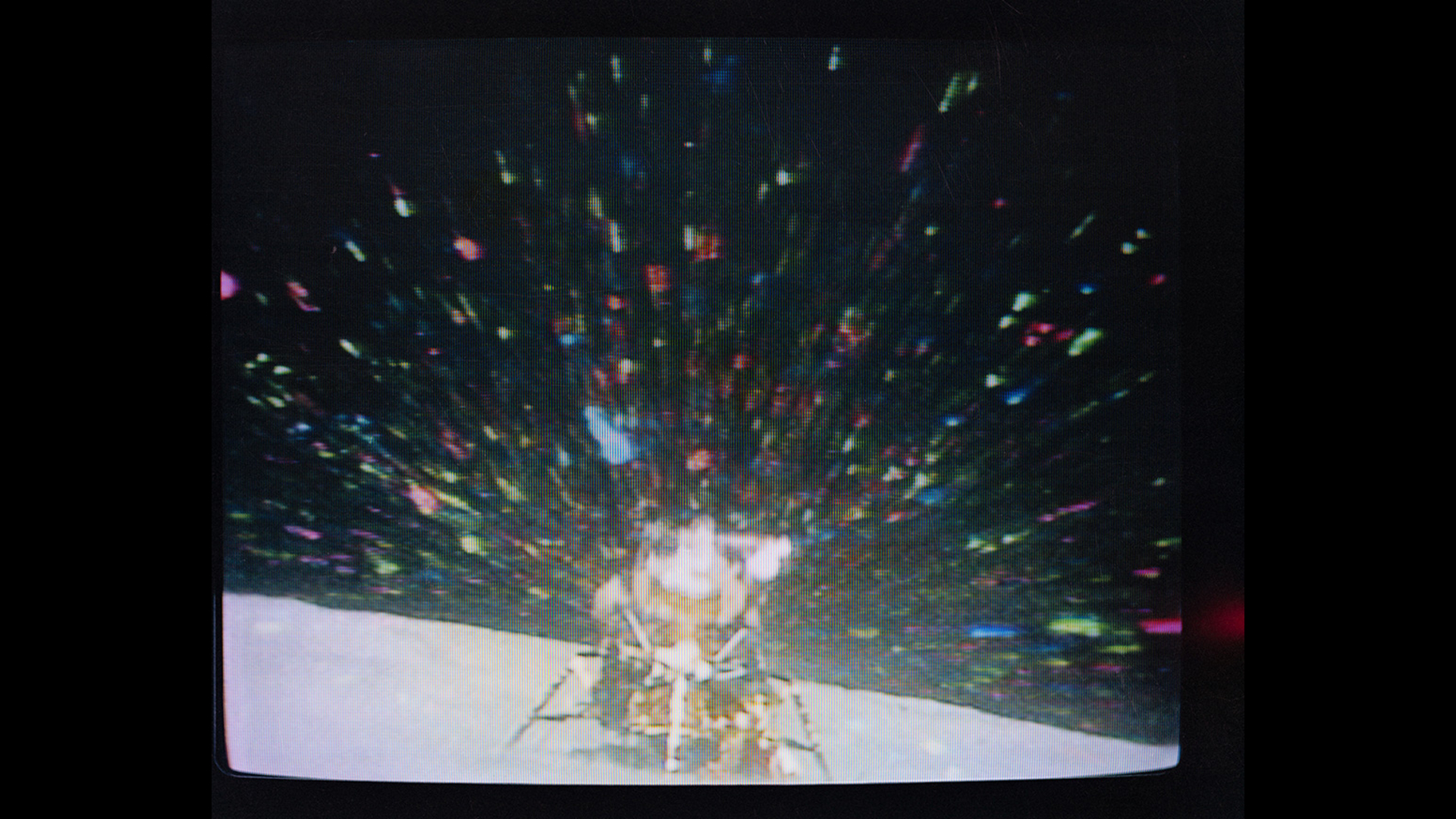
This image of the Lunar Module known as "Orion" during liftoff from the moon was taken from film beamed back to Earth from the RCA TV mounted on the Lunar Roving Vehicle.
Astronauts John W. Young, commander; and Charles M. Duke Jr., lunar module pilot, maneuvered the Lunar Module from the lunar surface back to the Command and Service Modules known as "Casper" where astronaut Thomas K. Mattingly II command module pilot, waited in Lunar Orbit.
Service module inspection
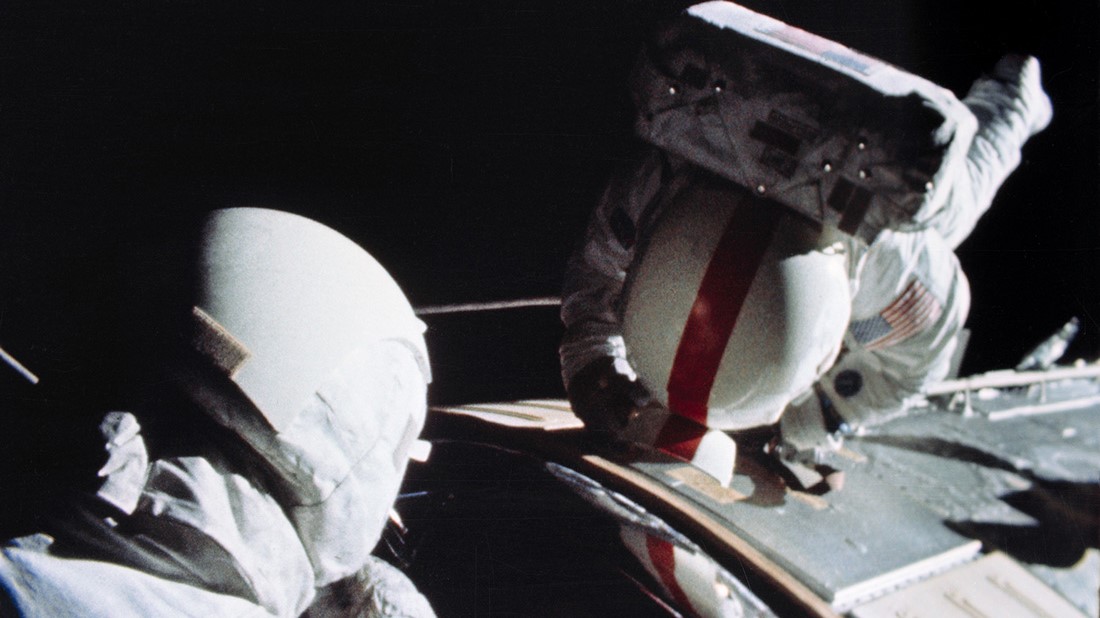
While on their way back to Earth from the moon, astronaut Thomas K. Mattingly II, command module pilot, inspected the Service Module, retrieving film from the Mapping and Panoramic Cameras in the process.
Astronaut Charles M. Duke, Jr., lunar module pilot, assisted Mattingly during the extravehicular activity. Mattingly donned astronaut John W. Young's, commander, helmet to protect his eyes from the sun in this image taken from motion picture film captured by the 16mm Maurer camera.
Breathtaking perspective
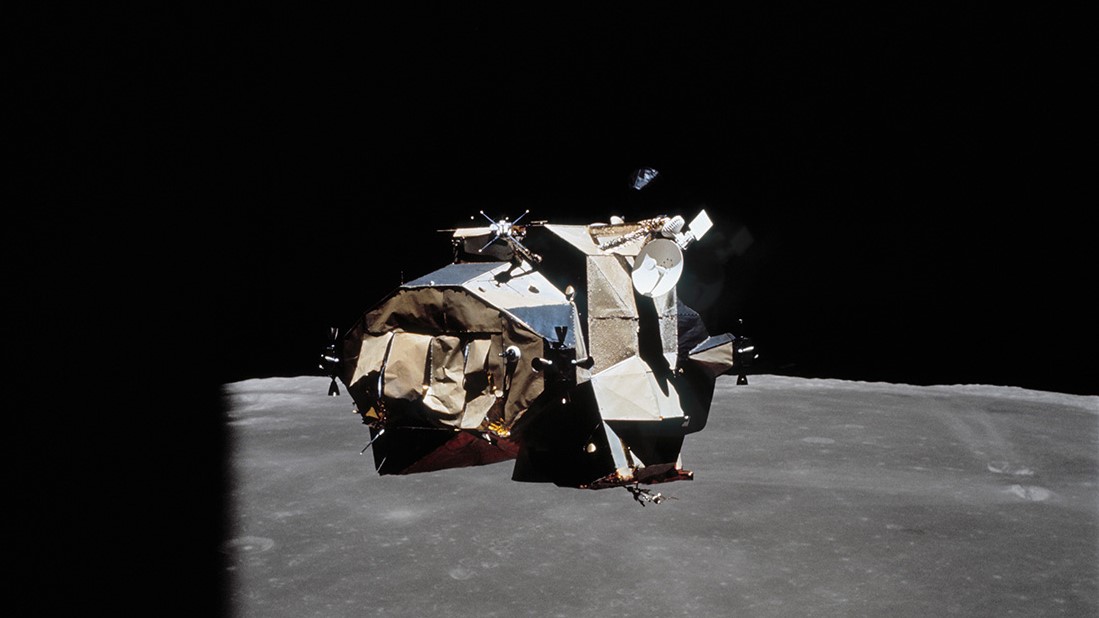
With a backdrop consisting of the inky blackness of space contrasted against the moon's Sea of Fertility, the Apollo 16 Lunar Module approaches the waiting Command and Service Modules. The aft side of the Lunar Module is visible while the craft is in a yam maneuver.
Below on the lunar suface, Messier and Messier A at the right center are easily identifiable.
Parachuting home
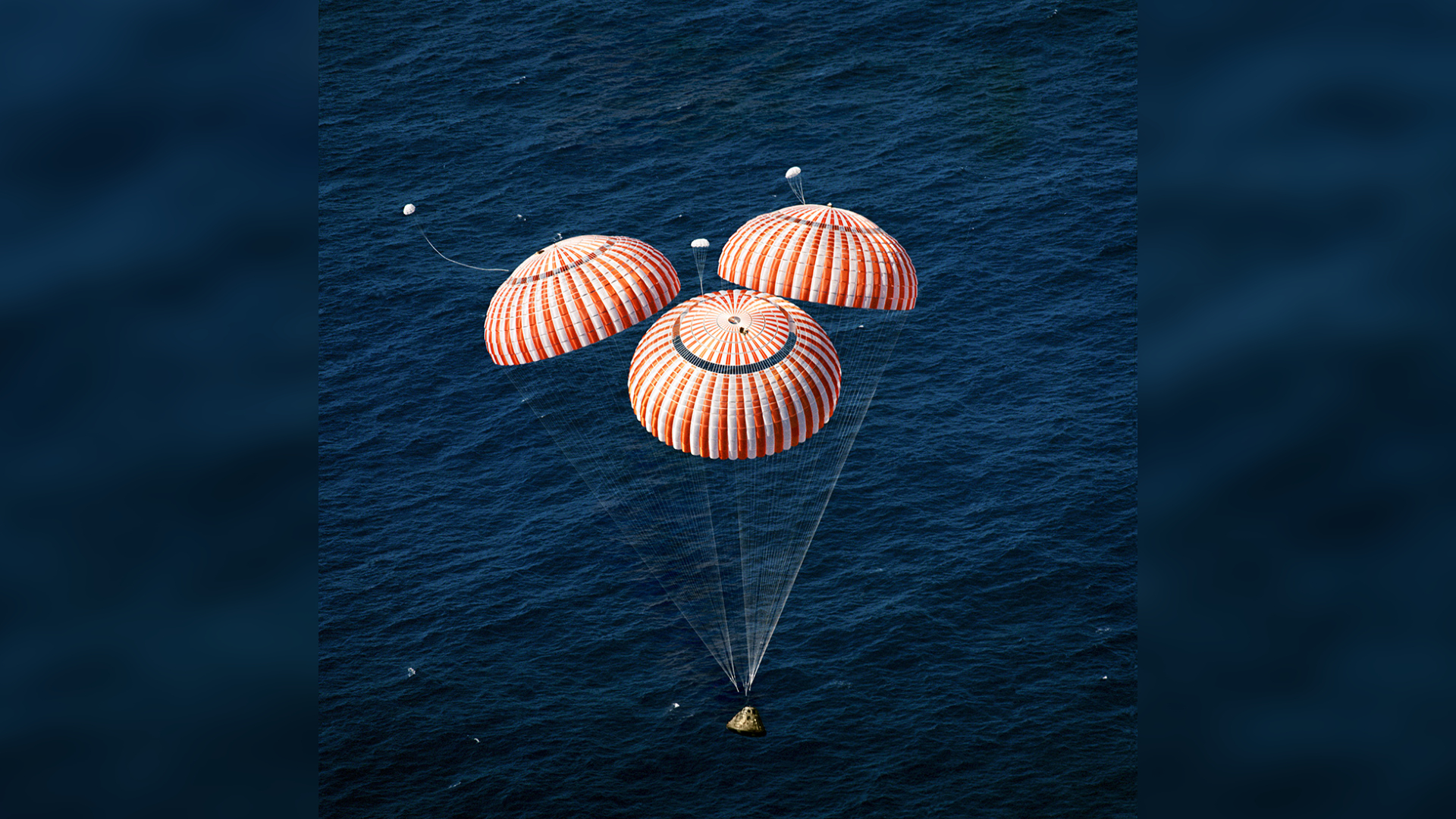
On April 27, 1972, astronauts John W. Young, Thomas K. Mattingly II, and Charles M. Duke Jr., return safely to Earth in the Apollo 16 Command Module.
The craft is near splashdown in the central Pacific Ocean.
Exiting the module
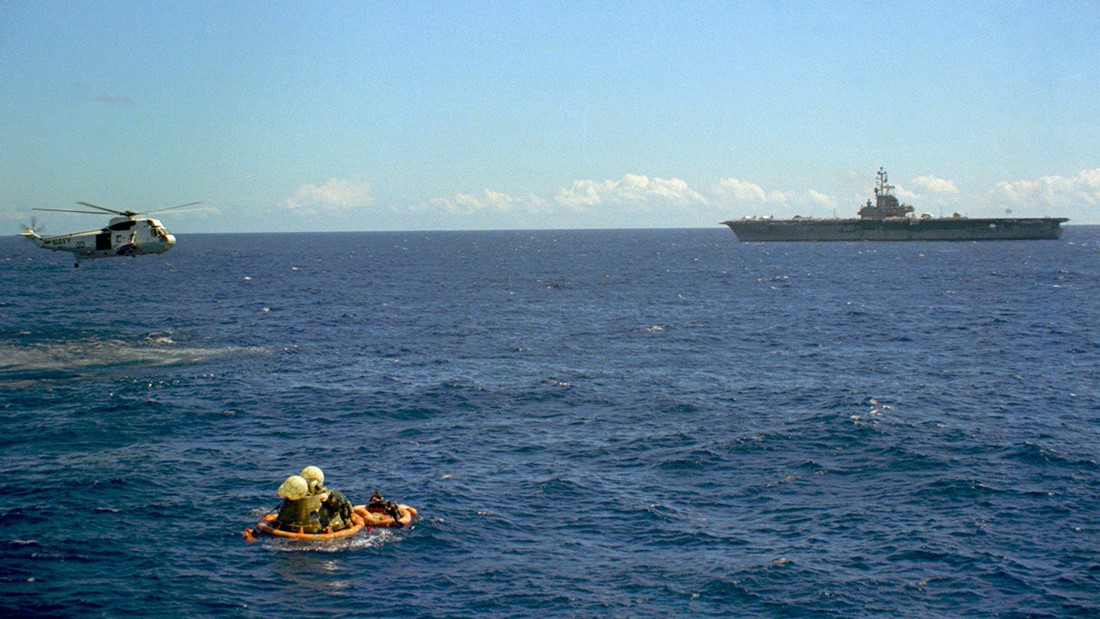
In the waters of the central Pacific Ocean the Apollo 16 Command Module floats during recovery operations by the prime recovery ship, USS Ticonderoga which is visible in the background.
Overhead, a recovery helicopter hovers, waiting to raise astronauts John W. Young, Thomas K. Mattingly II, and Charles M. Duke Jr., the Apollo 16 crew, to safety. In the water a team of Earth Landing System swimmers assisted the astronauts.
Examining the goods
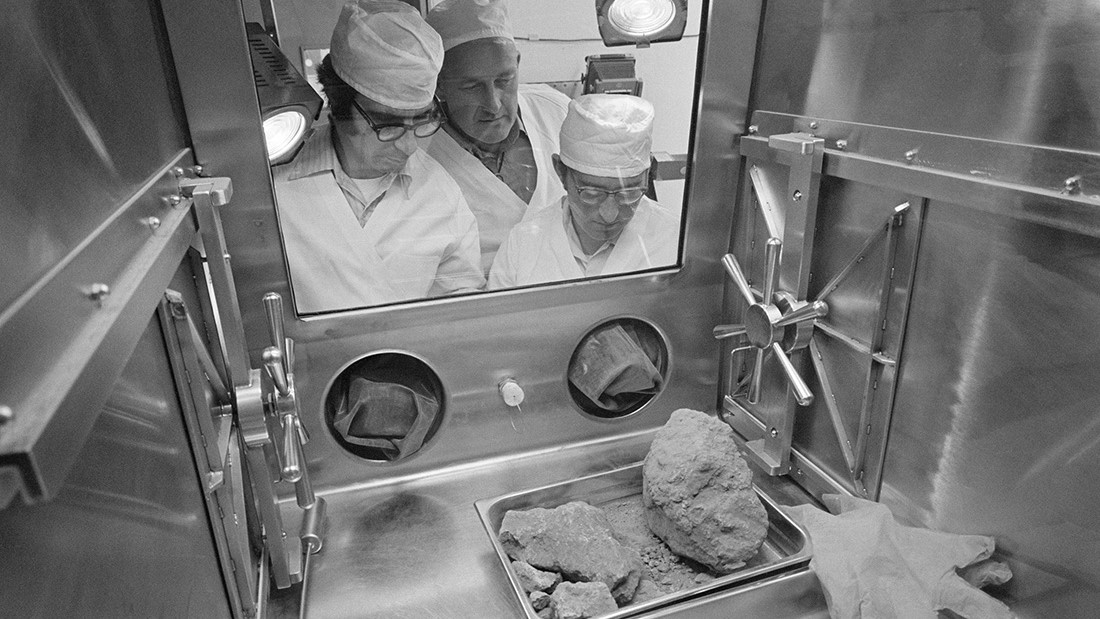
At the Manned Spacecraft Center's Lunar Receiving Laboratory in an secluded section geologists Don Morrison (left) and Fred Horz (right) and University of Texas geologist/professor William (Bill) Muehlberger inspect a special rock from the Apollo 16 mission.
Lunar sample 61016, known as "Big Muley," is the largest moon rock from any Apollo mission and is named after Muehlberger, the field geology team leader for the Apollo 16 mission.
Moon rock treasure
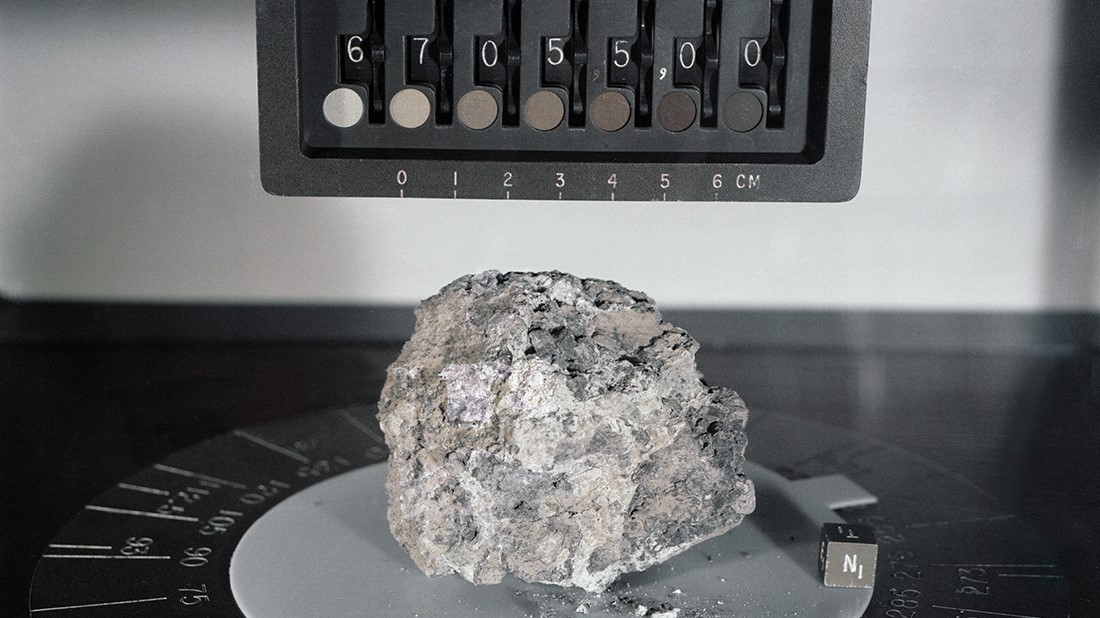
From the rim of North Ray Crater, a black and white breccia with several types of rock noted as inclusions. The light, feldspar-rich, fine grained matrix is fragile.
Join our Space Forums to keep talking space on the latest missions, night sky and more! And if you have a news tip, correction or comment, let us know at: community@space.com.
Get the Space.com Newsletter
Breaking space news, the latest updates on rocket launches, skywatching events and more!
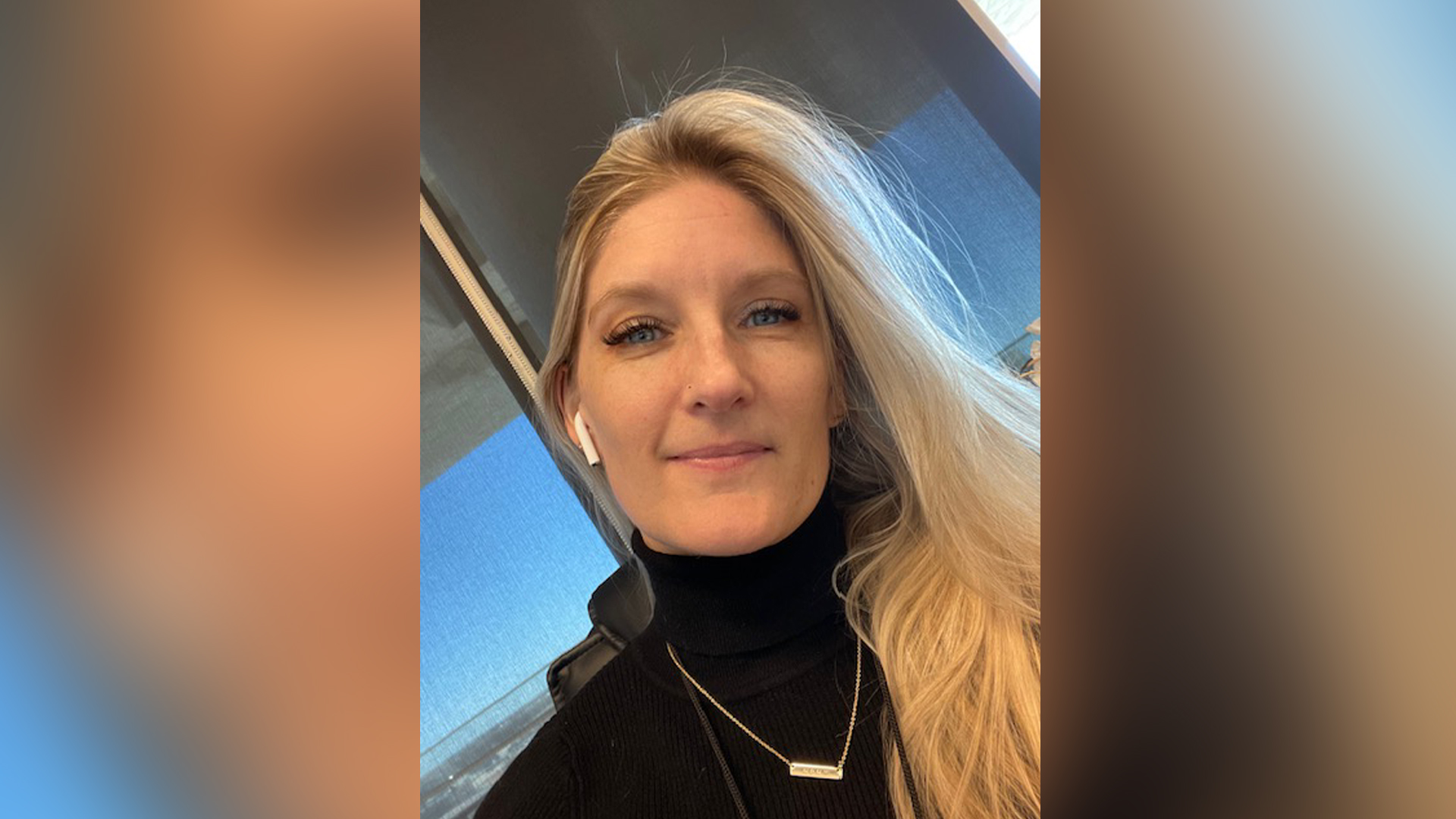
Christine Lunsford joined the Space.com team in 2010 as a freelance producer and later became a contributing writer, covering astrophotography images, astronomy photos and amazing space galleries and more. During her more than 10 years with Space.com, oversaw the site's monthly skywatching updates and produced overnight features and stories on the latest space discoveries. She enjoys learning about subjects of all kinds.
- Daisy DobrijevicReference Editor










